#the big beef 1945
Explore tagged Tumblr posts
Text






Eddy x Florence
#edgar kennedy#florence lake#ears of experience 1938#sock me to sleep 1935#the big beef 1945#two for the money 1942#in-laws are out 1934
0 notes
Text
Eddy x Florence slow-burn collection: What, No Cigarettes? (1945), Wall Street Blues (1946)
"You're too fat!" & "Shut up": Fish Feathers (1932), Brick-A-Brac (1935), Two for the Money (1942), Sock Me to Sleep (1935), Radio Rampage (1944), Wall Street Blues (1946)
Tender moments: Sock Me to Sleep (1935), Ears of Experience (1938), Love on a Ladder (1934), Rough on Rents (1942), What, No Cigarettes? (1945), In-Laws Are Out (1934), The Big Beef (1945), Two for the Money (1942)
Eddy, mother-in-law and brother-in-law: Duck Soup (1942), Edgar Hamlet (1935)
Jeanie With The Light Brown Hair: Social Terrors (1946). Sung by Edgar Kennedy, his wife(Florence Lake), his mother-in-law(Dot Farley), his brother-in-law(Jack Rice), his brother-in-law's sweetheart(Phyllis Kennedy) and his brother-in-law's sweetheart's parents(Paul Maxey, Vivien Oakland).
#edgar kennedy#florence lake#what no cigarettes? 1945#wall street blues 1946#fish feathers 1932#brick-a-brac 1935#two for the money 1942#sock me to sleep 1935#radio rampage 1944#ears of experience 1938#love on a ladder 1934#rough on rents 1942#in-laws are out 1934#the big beef 1945#duck soup 1942#edgar hamlet 1935#social terrors 1946#dot farley#jack rice#phyllis kennedy#paul maxey#vivien oakland
1 note
·
View note
Text
instagram
IWTV S2 Musings - Romania BTS deets! (Pt2: Tentative Timeline Revisions again)
So, a few days ago I stumbled upon Carol Cutshall's Instagram posts about Daciana, Emilia, etc, which I discussed in Pt1. I didn't have the brain capacity, time, space or energy to also address this other post she made even earlier, back in July, which also includes Louis & Claudia's Eastern European itinerary!

The text is SMALL AF so I can barely read anything, but already I see major discrepancies:

Everything up until 1944 makes sense AFAIK, it's not contradicting any of the dates mentioned in 2x1 which I laid out here (x x):
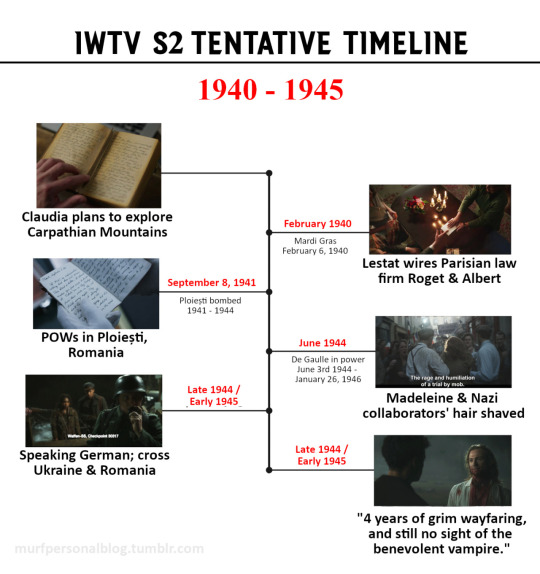
I REALLY wish we could read that list in full, cuz I had wondered what was going on with the Nazis calling them "Black Ukranians;" and if they were trying to enter OR leave Ukraine.
Funny enough, AMC seems to have forgotten that in 1x4 Claudia's diary also says they were in Romania on September 8, 1941--not that that means they couldn't've been there; just that the itinerary doesn't mention it (was that a mistake/oversight, or was the itinerary made before 1x4 was written/aired? 🤔).

So yeah, I'm fine with the 1941-1944 dates.
So here's another revised timeline for anyone interested:
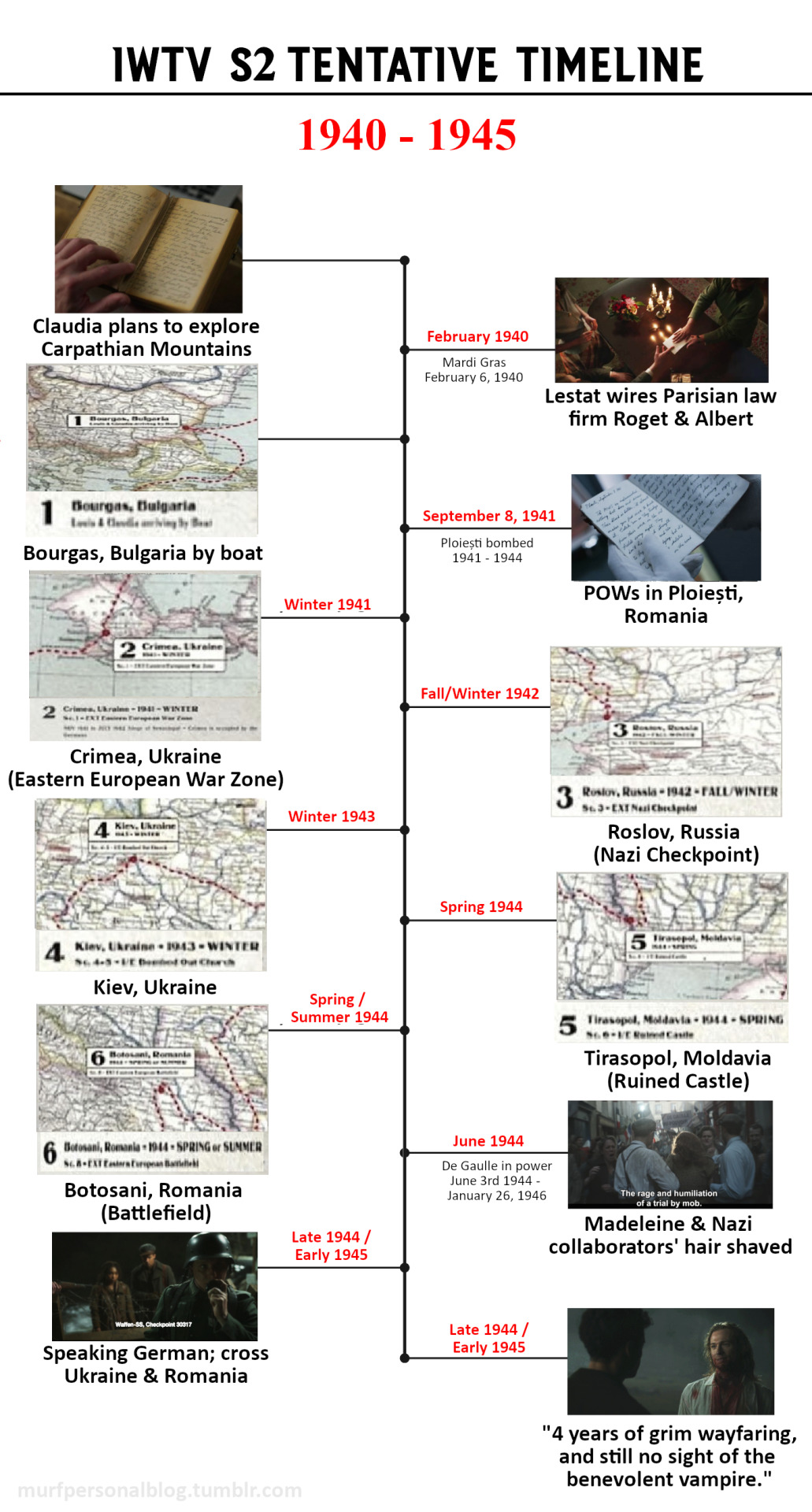
(EDIT: I dunno if we should consider this (old? obsolete?) itinerary as CANON, since the show itself never mentions them in any of these places/dates--this is a truly meta revision; so I'm keeping my original timeline as-is until we're told differently.)
Apparently, the "circuitous routes around the mad army" Louis said they traveled took them from:
Bouras, Bulgaria: they arrived via boat from Greece (so they probably crossed the Mediterranean via the Straits of Gibraltar, and bypassed Western Europe entirely)
Winter 1941 - Crimea, Ukraine: went northeast, crossing the Black Sea
Fall/Winter 1942 - Roslov, Russia: northeast
Winter 1943 - Kiev, Ukraine: northwest. Something about a church, but I can't read the rest *squints.*
Spring 1944 - Tiraspol, Moldavia: was the "ruined castle" supposed to be Cezare Romulo's!? that's super interesting if so, cuz that means at some point he lived in Romania near Daciana, to have killed that circus troupe IN SIBIU (Romania) & stolen their show bear, LOL. Why did he move to Moldavia? My headcanon says he wanted independence (like the IRL Moldavans), to break away from the Romanians/covens in the west and do his own thing out east--Daciana said "he was always a droll one." 👀 Vampire beef!? 😂🤣 Regardless, this might support my suspicion that although AMC filmed Cezare's castle at Tocnik, that was just for convenience's sake--we're probably not supposed to take any contextual clues from the IRL castle, the way I did for Daciana. So Cezare could be from ANYWHERE, really. Very cool!
Spring/Summer 1944 - Botosani, Romania: northwest
But it's as soon as we hit 1945 that a few snags appear.

While it's very cool that we now have an exact location for where Emilia's factory & Daciana's home would've been located (Biertan, Romania--so I was right that AMC was pulling inspo from Biertan!), there's a BIG problem:
Louis & Claudia couldn't've been in/entering Biertan, Romania in Fall 1945, and in France's Saint-Jean Lespinasse in Winter 1945, based on what we saw in the episode itself--namely:

In 2x1 Lou & Claudia were on the convoy delivering the Venus de Milo to Paris, which was already back in the Louvre by July 2, 1945. It had been hidden away with the rest of the Louvre's art for safekeeping during WWII in Château de Valençay (x x)--which is in a totally different commune from the Saint-Jean commune (which is much farther south). But the truck they were on would've still been IN France during the Spring/Summer 1945, NOT way out in Eastern Europe during the Fall/Winter 1945.
(What's interesting is that a famous art piece was indeed (temporarily) hidden in Saint-Jean, at the Château de Montal, but it wasn't Venus de Milo. It was THE Mona Lisa, which was also returned to the Louvre even earlier, on June 16, 1945.)
So there must've been a change at some point where the writers decided to add Venus and just ignore this itinerary--they even make a point to have Louis reunite with Venus later on in 2x4:


So it's not as if it was just an accident that Venus kept showing up in post-war Paris--just as Louis was starting a new romance with Armand under THE Goddess of Love/Lust's auspices.


So this just REALLY make me wonder WHEN that itinerary was mapped out, wrt to what we actually got on screen and in the S2 transcript (and ofc whatever was going on with the writer's strike); cuz it just doesn't make chronological sense to hold those last 2 dates at face value; they're just wrong. :\
*sigh* This is equal parts fun & frustrating; AMC, have mercy~! 😅
#interview with the vampire#iwtv tvc metas#the vampire daciana#loumand#justice for claudia#i hate math#europe#read a dang history book
8 notes
·
View notes
Text

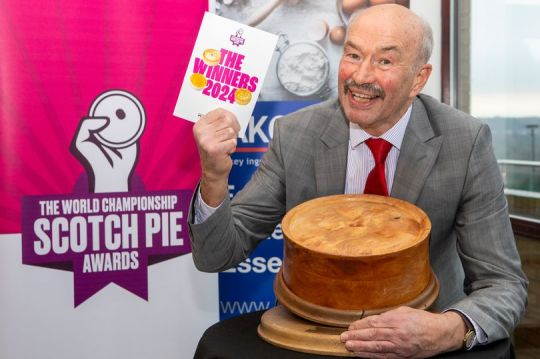

January 23rd is National Pie day, what's your favourite pie?
Is it the traditional New Years day fare, of a muckle steak pie, or the humble Scotch Pie filled with mutton? It could also be a macaroni pie, possibly a favourite with the vegetarians Scots out there. Or maybe you have sought out the Breakfast pie that I posted about previously is made by Table 13 Express takeaway deli in Kirkintilloch. The Haggis and Steak Pie by Bells is also up there, although I preferred the haggis mash and beans pies we used to get from our local bakers growing up in my hometown of Loanhead.
Perhaps the most famous of our pies here in Scotland is the award winning Killie Pie made by Brownings Bakery in the town since 1945.
Just last week Scotlans best pie was announced at The World Championship Scotch Pie Awards, with a beloved Perth and Kinross butcher taking home the top prize at the ceremony. More than 50 bakeries and butchers from around Scotland were shortlisted in a range of categories, with their bakes assessed anonymously by a panel of experts and independent judges.
This year, the top World Champion prize was given to James Pirie & Son of Blairgowrie, who previously won the competition in 2018, 2020, and 2022, as well as taking the title of World Scotch Pie Champion of Champions in 2021 with their iconic Scotch Pie.
Elsewhere, fellow winners included James Aitken Butchers in Alloa, The Little Bakery in Dumfries, and Beefcake Cafe in Glasgow, who took home prizes in the Sausage Roll, Bridie, and Vegetarian Savoury categories respectively. Among the other categories were Steak Pie and Haggis Savoury, which were awarded to Brownings the Bakers Ltd in Kilmarnock and WeeCOOK in Carnoustie.
Here's a recipe for the Scotch Pie, although they will differ from source to source.
EQUIPMENT NEEDED TO MAKE THIS RECIPE
Four 4-inch springform cake pans (or equivalent)
Rolling pin
Small skillet
Knife to cut onion
Saucepan/s
Measuring cups, spoons
Kitchen scale (optional)
Mixing Bowls and spoons
Pastry Brush (for egg wash)
Stove and Oven (obviously)
INGREDIENTS
Hot Water Pastry Crust
2 cups flour (240 grams)
1/2 cup lard or shortening
1/2 cup water
1/2 teaspoon salt
1 egg yolk, beaten (for egg wash)
Meat Filling
1 small onion, chopped fine
1 – 2 teaspoons lard, butter, or shortening
1 pound lean ground beef
1 teaspoon kosher salt
1/2 teaspoon pepper
1/2 teaspoon mace
1/2 teaspoon nutmeg
1 teaspoon Italian spice (optional)
Quick Beef Gravy
1 14 oz. can low sodium chicken broth
2 cubes beef bouillon
1/4 cup cold water
2 tablespoons corn starch
2 tablespoons corn starch
DIRECTIONS
Preheat oven to 350° F or 177° C. Grease four 4 inch springform pans and set aside.
Put flour in a medium mixing bowl and create a well in the center.
Place water, salt, and lard in a saucepan and bring to a boil.
Carefully pour hot water and lard into well made in the flour. Mix with a spoon until all the flour is wet.
When the flour mixture is cool enough to handle. Knead just enough to mix completely. Set aside one fourth of the dough and divide the remaining dough into four balls.
2 tablespoons corn starch
DIRECTIONS
Preheat oven to 350° F or 177° C. Grease four 4 inch springform pans and set aside.
Put flour in a medium mixing bowl and create a well in the center.
Place water, salt, and lard in a saucepan and bring to a boil.
Carefully pour hot water and lard into well made in the flour. Mix with a spoon until all the flour is wet.
When the flour mixture is cool enough to handle. Knead just enough to mix completely. Set aside one fourth of the dough and divide the remaining dough into four balls.
Place all of the dough in the refrigerator while sautéing the onions and preparing the meat mixture.
Sauté the chopped onion in 1 to 2 teaspoons of lard, butter, or shortening, until soft.
Thoroughly mix ground beef, onion, and spices, including salt and pepper, in a bowl and set aside.
Remove dough from the refrigerator and roll each of the four big dough balls into round shapes big enough to cover the bottom and up the sides of the springform pans stopping about 1/4 inch or 6 mm from the top of the pan.
Roll out the large piece of dough, (the fourth you cut off from the whole dough mass in the beginning), into one large shape a little thinner than the bottom shells. Using one of the springform pans, cut four circles out of the rolled dough. These will be the lids (top crusts) of your pies. Lay them flat and cut a small hole in the center of each lid.
Add one fourth of the meat mixture to each pastry lined pan. Filling to about 1/4 inch or 6 mm from the top of the dough. Be sure to push it down into the corner round the bottom of the pan.
Cover the pie with the pastry lids and press the edges of the lid dough into the shell dough to seal. You may crimp with your fingers or press with a fork to make them pretty or just leave them plain. Just make sure the tops and sides are sealed together.
Brush each lid with the beaten egg yolk and place the pies in the oven for 35 to 40 minutes. You can stick a meat thermometer into the lid hole to ensure the meat is cooked through. It should be 160° F or 71° C.
While the pies are in the oven, make the quick gravy. Put the chicken broth in a saucepan along with two beef bouillon cubes and bring to a boil. Mix 2 tablespoons of corn starch into 1/4 cup cold water and stir until smooth. Slowly, add the corn starch mixture to the broth while stirring. Turn down the heat to a simmer and allow the gravy to thicken, stirring occasionally.
Remove the pies from the oven and allow to cool for 5 to 10 minutes before removing springforms. Serve with gravy, potatoes, and vegetables, top with beans, or, just eat them on the go.
NOTES
If you want to put a tablespoon of gravy inside each pie before baking them, just make the gravy before assembling the pies.
Scotch pies will last 3 days in the refrigerator and can be frozen after they have cooled for an hour. They will taste best if eaten within two to three months of freezing. Once you have thawed the pies, don’t refreeze them.
Recipe taken from https://travelinginmykitchen.com/2022/01/03/make-your-own-scotch-pies/
41 notes
·
View notes
Text
PREACH! As a book reader, I'm 100% Team Lestat Was Forced & Injured. But I've discussed this Sam article before, cuz I have a lot of issues with IWTV's plot holes. My biggest beef with S2 is that AMC didn't film/write 2x7 & especially 2x8 adequately, to properly convey that something was going on. I NEED the Trial revisted from Les' POV, cuz there's way too much inconsistency & contradictions, and not in a good way.
THE TIMELINE
The timeline in S2 is all over the place, and we have no idea when Lestat was contacted by the coven, and where he was staying for however long he was in Paris. Louis & Claudia were there around 1945 - 1949, but Armand knew the day they arrived at the Theatre that they were lying about Lestat/Bruce. So was Lestat contacted immediately? Armand was able to do it all by himself in 1973--why rely on Santiago/Celeste/Estelle to do it in 1949?

I doubt Lestat went to Paris of his own volition (he'd've been too ashamed & guilty to go after them, just like the 6 years he spent in Algiers after 1x5)--so I'm convinced the coven definitely called Les & told him to come to Paris. But that presents a HUGE problem:

Exactly. Cuz HAYL NAW it doesn't take that long for vamps to heal. (This new Mind-Over-Matter-Gift was also Rolin's reason for adding the line about Les "not being in the mood" to burn to death in 2x8. But like I said, I don't believe Les when he says this, cuz it directly contradicts whole plotlines in the books AND show.)
If Les only arrived in 1949, I'd assume Les was already fully healed by then, nearly a decade after Mardi Gras, since Les wasn't set on fire a la the book. Meaning: if Les knew Louis was in danger, and he was back to full health, WHY TF didn't Les stop the coven before the Trial?
If Les arrived in Paris in 1945ish (right after 2x3 when Armand grills Lou about "Bruce"), I can maybe accept that he was still be weak from Mardi Gras (but again: like Sam already said, it was just a slit throat NBD vampires heal from cuts EASY; and he puked up & bled out most of the poisoned blood before Louis threw him on the trunk; and he had plenty of "big f*****g rats, enough blood in them to bring back the dead" to get strong enough to return to town & hunt humans). So by all counts (unless we buy Rolin's psychological damage > Swamp King propaganda), Les should've been fine in Paris--so why cooperate with the stupid rehearsals?


Solution: We NEED a scene where Lestat & Armand fight, a la the book's Tower Scene in TVL, where Armand effs Les up, breaks all his bones, then throws him in the dungeon/wet room/whatever to starve.
It's way more likely that Armand fought & captured & starved Les:
for 4+ years if Les arrived in 1945ish, right after Lou busted Claudia's "Bruce" lie in 2x3
for less than 1 year if they woke him in 1949, right before the Trial was prepped in 2x6
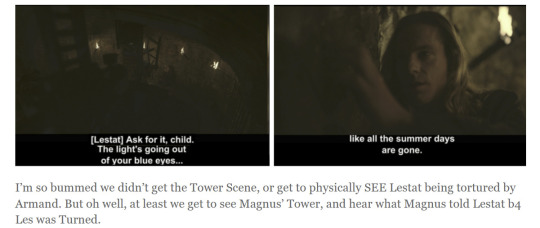
THE BRUISES
I've already ranted about my take on Les' injuries, both wrt Les being all bloody in the Ep5 revisit; and his hand/wrist bruises in 2x7.

PSYCHOLOGICAL INJURY

Sorry, AMC, but I've discussed before how IMO this is the weakest & least convincing bit. Sam even said he DISAGREED with Rolin's vision that Les be psychologically rather than physically hurt, and that Sam preferred Swamp King. Cuz this is TELEVISION, not a BOOK--some things you really NEED to SHOW US (and Tell us). Psychological pain preventing his supernatural healing does NOT translate well on screen without explicit explanation that this is something vampires can suddenly do; esp. since NO physical injury should hurt strong AF vampires in the first place--a la 1x5 & 1x6.

THE SHAKING
The Reddit fans clipped the wobbling in question:

But it doesn't prove Les was injured BEFORE joining the Trial--it's actually proof that he was weak AFTER Banishment; as he's now too weak to save Claudia, so he stands there just weak & wobbling.

Cuz where was this shaky & wobbly Les for the rest of the Trial? One thing that irritated me was how much he got in & out of his seat.



He makes grand gesticulations as he talks from the script, "the finest actor to grace our stage." Not ONCE do we see him wobbly & shaking, or any indication that he's low on blood or power--he even teleports all the way up to the stands to ream the homophobic soldier & read his mind & then teleport back to his seat. So it's not as if he's busy conserving energy.
But we DO see the psychological damage Rolin wanted, every time he's sitting down, and he goes OFF script--he's a wreck after he gaslights Lou about Come to Me, and when admits he broke Lou.

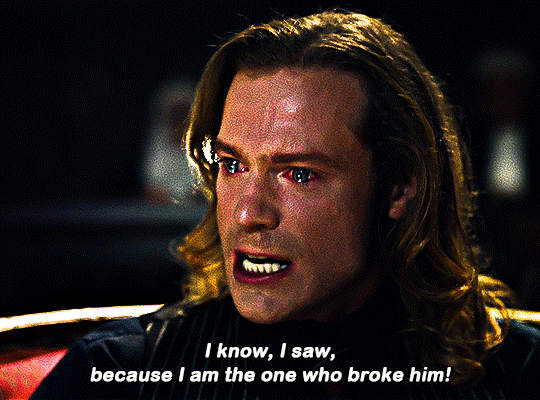
And it's just such a shame that Lestat never rubs his wrists, or adjusts the cuffs of his shirt, or rubs his knuckles (one Reddit theory even surmised that Armand might've cut his hands off a la Nicki, which I LOVE). We see him fidget with the wedding ring, and that's it. If he's bruised & in pain, we should've seen way more than some suspect discoloration on his hands; so that way when we got to the Tower Scene in 2x8 and saw the handcuffs we'd be like waaaait....👀
And we should've DEFINITELY seen it during the Rehearsal, AMC.

Like, sure, Lestat was mumbling those lines--he clearly doesn't wanna be there or take part in the Trial. But that's not an indication that anything's psychologically/physically WEAKENING him--esp. since he gets up and walks & talks just fine right after, checking out the mannequins & sassing Armand. His only problem's the logistics of the Trial itself.

If anything, the sheer fact that Lestat had to ask what Armand & the coven would do to force Claudia to stay quiet means that they hadn't used the Mind Gift on him that whole time in rehearsals, to mentally fog/compel him to say his lines--and we definitely don't see it used on him during the Trial, not even when he's going wildly off script--they shut off the projector, but didn't make HIM stfu? 🤨
But the REAL problem is: neither the bruises not the shaking are anywhere to be seen!
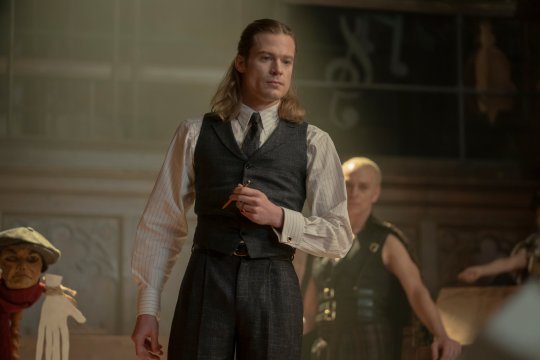
So what are we supposed to conclude? That Lestat WAS fine during the whole Rehearsal bit, and it was only AFTER he yelled about Claudia's strength that Armand chained him up or cut off his hands? If so, I'm fine with retaliatory measures!
But it still begs the question why Les didn't do anything BEFORE the Trial. No warning, no nothing. So we'd have to assume that he IS a prisoner of the coven's the whole time--and cuz he's stronger than everyone but Armand, we'd also have to assume that Armand did something to him from the very beginning...which we don't see. Esp. since this is the Rehearsal that's exposing Armand's sins, so it's not like it's necessary to hide that Les was hurt the whole time.
Waiting allllll the way to reveal it in S3 was risky AF, and a horrible idea if it was intentional, cuz it just gives the fans more time to look at Lestat sideways. This whole months-long discourse just proves that AMC did NOT adequately show that Les was under duress. The chances they had to really show & tell us came & went in 2x7 AND 2x8.
TL;DR: I love the Injured Lestat theory, and I fully believe he was hurt, cuz that's what happened in the books--I'll be FURIOUS if AMC doesn't revisit the Trial to fix this. I just hate the way this has all been executed.
Redo the scenes with Lestat's hands to zoom in on them, and emphasize that he was effed up; and show him wobbling & weak & Ming-Fogged BEFORE Banishment.
This show is effing excellent, but it's not perfect, and there are glaring mistakes they need to fix ASAP, if they want us all on the same page that Les really was a victim of Armand's abuse, too.
I was reminded of this interview. I completely forgot Sam said all this.
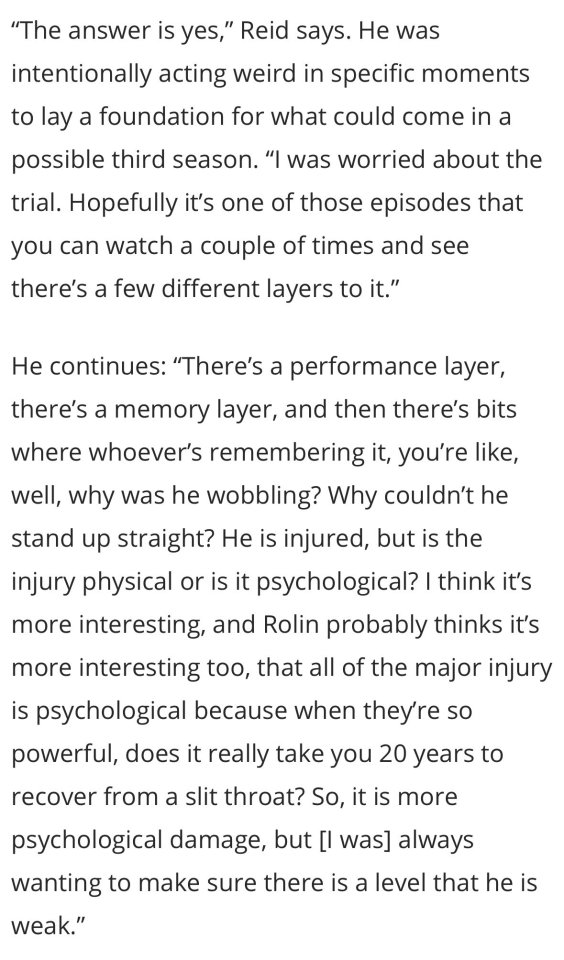
How does the "Lestat wasn't weakened at the trial and he was happy to be there" crowd feel about this?
#lestat de lioncourt#the vampire lestat#the vampire armand#interview with the vampire#iwtv tvc metas
615 notes
·
View notes
Text
FMP
Dai Pai Dong Timeline - Body copy for outcome
1940s
In 1941, Japan attacked and occupied Hong Kong, causing many citizens of the colony to become imprisoned with limited access to food and other resources. 3,000 British women and children were evacuated. In 1945, British troops returned and the civil government was reestablished. Hong Kong faced many challenges in rebuilding its economy and infrastructure. Also at this time, an influx of mainland Chinese residents fled to Hong Kong due to political instability in Mainland China at the time.
Unlicensed food stalls had been around since the early 1900s, particularly around Wan Chai and Central areas. After world war II had ended, the colonial Hong Kong government issued licenses to families of deceased and injured civil servants and mainland Chinese residents, which allowed them to operate food stalls in public to earn a living. This type of license was physically larger than normal ones, as a photograph of the license was required to appear on them.
The license was jokingly called 'dai pai' (big license) by locals and from then on, 'big license stalls' began to show up all over Hong Kong's streets.
1950s
During the 1950s, Dai Pai Dong was popular among the working class due to their cheap prices, it even earned the nickname 'poor people's nightclub'. Each stall specialised in different dishes, such as wonton noodles or beef brisket noodles.
Dai Pai Dong soon became the cause of traffic congestion, noise complaints and hygiene problems. some licensees even began to let out their stalls on the black market.
The government in response stopped issuing these new licenses in 1956, as well as limiting their transfer. Licenses could only be passed on to spouses upon the licensee's death, and if the licensee did not have a partner, the license would just expire.
1960-1970s
Dai Pai Dong peaked in the 1960s and 1970s, when a lot of local Hong Kong residents could not afford to dine at high end restaurants, so opted for cheaper, local dishes. Dai Pai Dongs were everywhere and easily accessible, mostly popular with families and workers who were working class.
Dai Pai Dongs were not only restaurants but also outdoor food stalls where locals could buy street food quickly and easily. In the 1960s, the population was high due to an increase in refugees from China. These refugees made up a bulk of the numbers for the lower class at the time. A lot of the Dai Pai Dongs were ran by these Mainland Chinese refugees due to the licenses that were given out by the government to help them make money to live.
Since 1975, the first cooked food centre opened in attempt to shift Dai Pai Dong to a more controlled environment. This was successful as many did move, however there were still a few that remained on the streets.
1980s
In 1983, the government began buying back licenses from stalls as they were causing congestion. There was also some hygiene issues that were raised. Since most license holders were now older and their licenses are only transferable to their spouses, many were willing to return their licenses for financial compensation. The government was offering up to a million Hong Kong dollars for each one to speed up the process. Since then, the number of traditional, authentic Dai Pai Dong has declined.
Kowloon City, which had 68 Dai Pai Dong had none by 1984, showing the sharp decline due to the cash payout. Many Dai Pai Dong continued business and to moved to temporary markets and cooked food markets that were indoors to reduce hygiene issues and congestion.
1990s
The 90s was a significant time for Hong Kong, as in 1997, the handover would occur. This created a lot of uncertainty in Hong Kong at the time. This caused a lot of people - particularly westerners to migrate overseas. During the 90s, Hong Kong experienced a boom in personal consumption
As more and more people could afford more expensive foods due to the rising of Hong Kong's economy, this sped up the process of Dai Pai Dong extinction. At the time, hygiene was no longer the main concern for Dai Pai Dong, among the 200 complaints from the government, 90% were that the restaurants blocked the roads from being on the street side.
2000s
Due to the location of Kai Tak airport, this stunted the growth of Kowloon which was already overpopulated. Building heights were restricted and no flashing lights were allowed. In 2005, the airport was moved to Lantau Island, which transformed Kowloon from a noisy, undesirable flight path zone to a priceless area. Redevelopment and regeneration took over Kowloon, forcing a lot of Dai Pai Dong to close, particularly in Sham Shui Po.
In 2005, Dai Pai Dong in Hong Kong received new public attention for preservation. Man Yuen Noodles, a popular Dai Pai Dong in central faced imminent closure due to the licensee passing away, which caused a big uproar. Many residents tried to protest against the government, however it was unsuccessful.
2010s - 2020s
Even as Dai Pai Dong begin to gain global recognition from tourists and locals, they still face extinction. The numbers have been and still continue to decline, with license transfer becoming more and more difficult. In 2014, there were only 25 left, and in 2024, only 18 remain. The government is aware that tourists want to visit these traditional, authentic places so the Central locations remain protected, but views differ in other districts.
Remaining Dai Pai Dongs have smartened up to attempt to compete with more expensive restaurants. Many have cleaned their premises and scaled down their outdoor areas, moving more indoors to stay alive. Open air kitchens facing the street still remain, however to remain afloat, much has changed over the years.
Attaché (2024). Hong Kong - is it still worth visiting? YouTube. Available at: https://www.youtube.com/watch?v=SQ041I-PcI4&ab_channel=Attach%C3%A9 [Accessed 18 Mar. 2024].
Asia Society. (2024). Asia Society Food Series - Dai Pai Dong Cuisine. [online] Available at: https://asiasociety.org/hong-kong/asia-society-food-series-dai-pai-dong-cuisine [Accessed 15 Mar. 2024].
British Pathe (1961). WELCOME+TO+PRINCESS. [online] British Pathé. Available at: https://www.britishpathe.com/asset/86183/ [Accessed 18 Mar. 2024].
British Pathe (2022). Stock Shots Hong Kong. [online] British Pathé. Available at: https://www.britishpathe.com/asset/105902/ [Accessed 18 Mar. 2024].
Hong Kong - Postwar, Economy, Politics | Britannica. (2024). In: Encyclopædia Britannica. [online] Available at: https://www.britannica.com/place/Hong-Kong/Postwar-Hong-Kong [Accessed 14 Mar. 2024].
Loc.gov. (2024). Hong Kong (August 1997) - Library of Congress Information Bulletin. [online] Available at: https://www.loc.gov/loc/lcib/9708/hongkong.html#:~:text=In%20December%201941%2C%20as%20it,reduced%20to%20approximately%20600%2C000%20residents. [Accessed 14 Mar. 2024].
South China Morning Post (2018). Take a tour of Hong Kong in the 60s. YouTube. Available at: https://www.youtube.com/watch?v=Wxbhwpl9pDw&ab_channel=SouthChinaMorningPost [Accessed 18 Mar. 2024].
Whitehead, K. (2014). Dai pai dong an endangered species in Hong Kong. [online] South China Morning Post. Available at: https://www.scmp.com/lifestyle/food-drink/article/1556158/dai-pai-dong-endangered-species-hong-kong [Accessed 18 Mar. 2024].
Young Post. (2020). Why are Hong Kong’s dai pai dong disappearing? [online] Available at: https://www.scmp.com/yp/discover/lifestyle/features/article/3097776/hong-kongs-dai-pai-dong-serving-citys-ultimate [Accessed 22 Mar. 2024].
HK Magazine (2005). Dai Pai Gone? [online] South China Morning Post. Available at: https://www.scmp.com/magazines/hk-magazine/article/2032727/dai-pai-gone [Accessed 22 Mar. 2024].
Imf.org. (2024). Occasional Paper 152--Hong Kong, China / Introduction and Overview. [online] Available at: https://www.imf.org/external/pubs/nft/op152/chap1.htm#:~:text=During%20the%20early%201990s%2C%20Hong,the%20external%20balance%20deteriorated%20sharply. [Accessed 22 Mar. 2024].
Treleaven, S. (2018). Hong Kong’s Dai Pai Dong Stalls Are Disappearing. [online] MyRecipes. Available at: https://www.myrecipes.com/extracrispy/hong-kongs-dai-pai-dong-stalls-are-disappearing [Accessed 22 Mar. 2024].
Wang, J. (2019). SCMP. [online] South China Morning Post. Available at: https://www.scmp.com/lifestyle/food-drink/article/3042554/why-hong-kongs-surviving-dai-pai-dongs-are-still-loved-and [Accessed 22 Mar. 2024].
0 notes
Note
What about a Patriarch Bruno AU? Maybe where he is the one in charge of his nieces and nephews or they are his kids? Idk I just think it would be an interesting idea
Okay!
TWs: Infertility issues!
In a town close to Bogotá, there lived the family Madrigal. The matriarch and patriarch of the family lived in a small house, Julieta and Pepa each live in different houses with their respective husbands, and Bruno was helping at his parent’s place.
Sure, Bruno had some beef with Ozma about her dead goldfish, but life was good.
It was wonderful, but nothing lasts forever…
One night, bandits raided the town, setting houses a light and slaughtering innocents…
The Madrigals attempted to run, but most didn’t even make it out of the town. Félix, Pepa, Julieta, Agustín, and Pedro were slaughtered by the bandits, Alma and Bruno even seeing some of them...
But as much as they wanted to go to them and comfort them in their last moment, there's no time for that, and Alma and Bruno had to get away.
A few other people from the now destroyed town also went the same way into the mountains, including Ozma.
The group went further into the mountains, and thought they were safe from the bandits, but they were wrong...
They managed to follow the group, intending to kill them...
Not wanting her son or anyone else to be killed, Alma sacrificed herself...
Both Bruno and Ozma had to see it, and the former
It was then that the miracle was created. Mountains appeared from the ground and a magical house came to life.
Bruno and Ozma were both 20 when it happened...
When the two stepped into the living house, Bruno and Ozma saw two golden glowing doors, and knew that they were kinda stuck together.
But that didn't really matter to Bruno, because he was processing the loss of his family...
Luckily, he and Ozma had separate rooms, and the house was quite big, so it was easy to avoid each other.
But eventually, the two talked about the raid, the loss of their respective families, and let out their pain.
Slowly but surely, the two started to get along, and became friends, especially when they were busy with the town.
After 5 years, the two fell in love, and married 3 years later.
Shortly after Bruno and Ozma got married, the town started to pressure them to have children, to continue the next generation.
The couple tried, they tried for years and years, but didn't succeed. It did result in one pregnancy, but Ozma unfortunately miscarried...
The couple were devastated, thinking they would never be parents...
More years passed, and the couple did try for a child once in a while, but it didn't result in anything...
Until, when Ozma and Bruno were both 44, the former was expecting again.
The couple were happy, but worry consumed them, afraid that it'll result in another miscarriage...
But it didn't, nothing concerning happened.
And even better, it was later clear that Ozma was pregnant with triplets.
The couple were over the moon, they're were finally gonna become parents.
and on the 11th of may 1945, the madrigal triplets were born. Alejandra, Juancho, and Cecilia.
After everything, Bruno and Ozma finally have their family, and they would make sure to protect them and keep them save.

#patriarch bruno au#bruno madrigal#señora pezmuerto#encanto alejandra#encanto juancho#encanto cecilia#encanto au
17 notes
·
View notes
Text
ROUGH ROAD TO TOP
August 16, 1953

(1)

One of the more famous CBS-TV shows is “I Love Lucy.”
Its two chief characters - Lucille Ball and Desi Arnaz - have had a rocky road to their present status as one of the top comedy teams in the country.
At the end of Lucille's first year in dramatic school she was told by her teachers that she was wasting her time and money, that she would never become an actress. She was fired from all four of her first jobs as a chorus girl. Later, as a model, she almost lost her life in an automobile accident and was told she would never walk again.
Revolution Factor
It was a revolution in Cuba and a mishap in World War II which were fateful turns in Arnaz’ trip to stardom. The Cuban revolution destroyed his family’s wealth, drove them to the United States. World War II got him a broken kneecap in basic training, and since he had been a professional entertainer, he was placed in limited service and assigned to entertain hospitalized G.I.s'.
Columbia Pictures gave Lucille a contract as a stock player, and, convinced that her luck finally had turned, she sent for mother, grandfather, and sister to join her in California. But, the morning after she wired her family, the studio decided to dissolve its stock company. When the family arrived, Lucille was working as an extra at Paramount.
Bit parts and extra roles in a number of pictures kept Lucille busy, but not prosperous, until she was cast in ’"Roberta.” RKO officials, impressed by her work, gave her a contract. When not busy before the cameras, she was a mainstay of the studio's Little Theater. (2)
Offered Stage Lead
Her performance in the second lead in “The Girl from Paris" (3) drew Broadway's attention to Miss Ball and she was offered a lead in the musical "Hey Diddle Diddle.” After satisfying her yen to perform on the Great White Way (4), she returned to Hollywood for "Stage Door” and “Too Many Girls.” In the latter picture, she was costarred with Desi Arnaz. They were married Nov. 30 1940 in Greenwich, Conn.
Back from her honeymoon, Lucille walked into her first really big break a role in "The Big Street,” based on a story by Damon Runyon (5). Overnight it made her a star.
Her first assignment at M.G.M. in 1942 was the title role in the Technicolor production "Du Barry Was a Lady” (6). Stellar roles followed in "Best Foot Forward” and "Meet the People" (7). After completing "Easy to Wed” with Van Johnson (8), she headed for New York to be with her husband, then out of the army and on his way to success in the orchestra business.
Starred on Tour
Shortly after completing "Her Husband’s Affairs,” (9) Miss Ball went on tour as star of Elmer Rice's play "Dream Girl” (10) then worked with Sonny Tufts and Victor Mature in "Interference” for R.K.O. (11)
Lucille, Desi, arid their year-old daughter Lucy Desiree, live at Desilu, their five-acre ranch at Chatsworth, Calif. They raise cattle, chickens, dogs, and cats and dabble in farming. Enthusiastic fishermen they spend a lot of time on their boat.
Desiderio Alberto Arnaz y de Acha was born in Santiago, Cuba, son of the mayor. Desi’s mother, Dolores de Acha, was considered among the 10 most beautiful women In Latin America.
Three ranches totaling 100,000 acres, a palatial home in the city, a private island in Santiago Bay, speedboats, a fleet of motor cars, and a racing stable were all at the command of the youthful Desi during the pre-revolutionary days. His father, after eight years as mayor of Santiago, was made a member of the Cuban congress In 1932.
On Aug. 12, 1933, came the revolution. Congress was dissolved. Its members jailed. The Arnaz property was confiscated, the homes burned to the ground. In 24 hours everything was gone except $500 Desi's mother had hidden. Desi and mother fled to Miami, devoted the next six months to efforts to free Papa Arnaz. from prison. They were finally reunited in Florida.
For Desi, life in these United States for several years was hard but interesting: he worked at truck driving, train yard checking, taxi driving, bookkeeping, and, of all things, bird cage cleaning. Desi’s father managed to launch an importing business. It went broke when a shipment of fruit spoiled in transit.
Show business at this point finally caught up with Desi. His first job was playing guitar and singing with a seven-piece rhumba band at Miami’s Roney-Plaza Hotel (12). Xavier Cugat (13) spotted him, was impressed with this Cuban boy who was to be dubbed "The Tempo” by critics of modem music. After a year as featured vocalist with the Cugat band, Desi organized his own group of musicians and moved into the swank La Conga Café in Miami (14).
George Abbott's Broadway hit "Too Many Girls” (15) was Desi’s next step up the ladder, in 1939. He played a Cuban football player, one of the leads, and played tropical drums. RKO bought the film rights and signed Desi to play his stage role. When the shooting was over Desi married the leading lady, Lucille Ball.
He spent from Feb. 1943 to Nov. 1945 in the Army, after which he toured the nation with his band playing theaters, dances, night clubs. He hasn’t been without a band since. In 1948, Desi made the Columbia film "Holiday in Havana.” (16)
He made a vaudeville tour with Lucille Ball and that convinced them they’d do well as a husband-and-wife team on television. The tour inspired the CBS-TV show “I Love Lucy,” which has been highly rated since it started. (17)
Desi Arnaz’s personality is as vibrant as the music he makes. He is friendly, direct in manner, has flashing dark brown eyes and brown hair. He’s an avid fisherman, rides and swims expertly: his tennis is the envy of his San Fernando Valley neighbors, Sue and Alan Ladd, Francis Lederer, Jackie Oakie, and the Andrews Sisters. (18) A good cook, he specializes in such tempting dishes as Ginger Beef and Bouillabaisse.
# # #
FOOTNOTES FROM THE FUTURE

(1) The photo is from “Be a Pal” (ILL S1;E2) aired on October 22, 1951, nearly two years earlier. There’s one thing missing from this file photo: Vivian Vance. The success of the show was its foursome, not threesome! If you look closely you can see the hands of the other poker players, Richard Reeves (Hank, left) and Tony Michaels (Charlie, right).
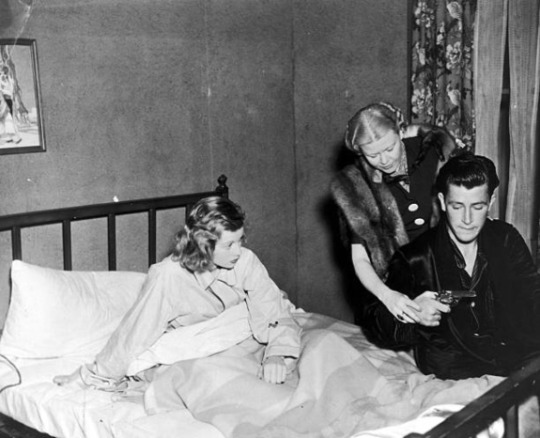
(2) Lucille did several plays at the RKO Little Theatre under the direction of Lela Rogers (above), Ginger’s mom. When Lucille later bought RKO, she dubbed it the Desilu Playhouse, a training ground for new young performers, often hand selected by Ball herself.
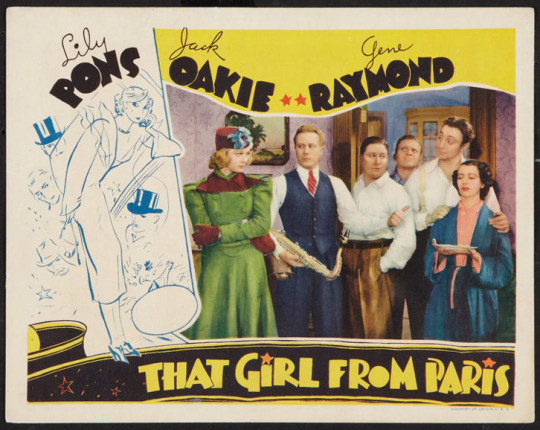
(3) “That Girl from Paris” (not “The” as the article states) was Lucille’s 33rd film. The light-hearted musical romance earned an Oscar nomination for Sound Recording. It was released on the first day of 1937.
(4) Lucille was indeed cast in the Broadway-bound comedy (it was not a musical, however) “Hey Diddle Diddle!” It opened in Princeton, New Jersey, the first of several out-of-town stops on the way to Broadway. What Lucille’s publicity omits is that the show never got further than Washington DC due to the serious illness of its leading man, Conway Tearle. So Lucy’s Broadway debut would have to wait - until 1960!
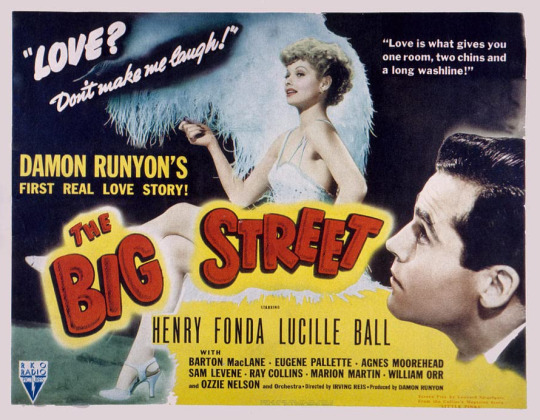
(5) “The Big Street” opened on September 4, 1942. It was based on a Damon Runyan short story about a night club singer (Lucille) embittered by an accident that left her in a wheelchair and her romance with a naïve admirer (Henry Fonda) named Pinks. Lucy later said it was her favorite of the many films she made. It was her 55th film.
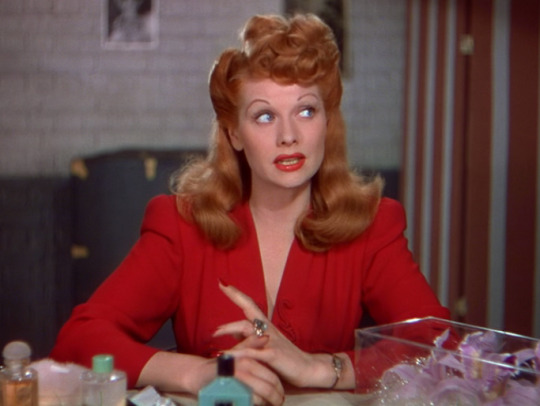
(6) “Du Barry Was A Lady” premiered in August 1943. It was Lucille’s 57th film, but her first for MGM. She nabbed the role from her friend Ethel Merman, who had done the Cole Porter musical comedy on Broadway. It was filmed in color, and was the film that earned her the nickname “Technicolor Tessie” because of her bright orange hair - a color she committed to from then on, despite her roots! This is the film that introduced Lucy to the song “Friendship”, which she would also sing on “I Love Lucy.”

(7) In the musical comedy “Best Foot Forward” (1943) Lucille Ball played herself. It was her 58th film. “Meet The People” (1944) was a romantic comedy for MGM, Ball’s 60th film.

(8) In 1946 she released her 63rd film, “Easy To Wed” co-starring Van Johnson and Esther Williams. Lucille and Van had appeared together in “Too Many Girls” and he would appear on Lucy’s television shows.
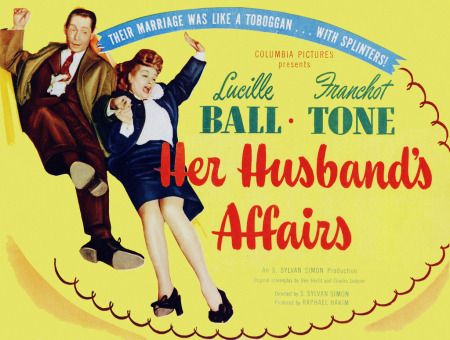
(9) “Her Husband’s Affairs” (1947) was a romantic farce with Lucy teamed with Franchot Tone. It was her 69th film.

(10) Back to the stage, Lucille accepted the leading role in a revival tour of “Dream Girl” a fantasy comedy by Elmer Rice. Once again, the play launched in Princeton, but this time Broadway was not the goal. It had already played the Great White Way two years earlier. The play toured the country at select cities, landing Lucille back in California in late 1947. In one SoCal gig she was appearing simultaneously with Desi and his band just a few blocks away. No doubt this was by design.

(11) RKO’s “Interference” was re-named “Easy Living” (1949) and dealt with the world of professional sports, namely football. It co-starred Victor Mature and Sonny Tufts. It was Ball’s 71st film.

(12) The luxurious Roney Plaza Hotel in Miami Beach was located on the corner of Collins Avenue and 23rd Street. It opened in 1925 and was demolished in 1968. The resort attracted a who's who that included Hollywood stars and even the Duke and Duchess of Windsor. The hotel's Bamboo Room & Restaurant was the place to be seen on the Beach for decades.
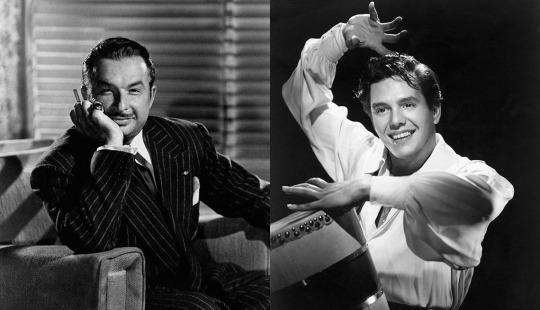
(13) Xaviar Cugat (1900-1990) was a Spanish musician and bandleader who spent his formative years in Havana, Cuba. A trained violinist and arranger, he was a leading figure in the spread of Latin music. In New York City he was the leader of the resident orchestra at the Waldorf–Astoria before and after World War II. He was a mentor and friend to Desi Arnaz, who kept his name before the public by making him a rival of Ricky Ricardo on “I Love Lucy” where his name became a punchline. In reality, Desi was grateful to Cugat, not jealous of him!
“I learned a lot from Xavier Cugat” ~ Desi Arnaz

(14) La Conga Café was located in New York City, not Miami, although the article may be referring to a different, lesser known establishment where Desi Arnaz performed. He became a regular headliner at La Conga, even issuing a record titled “La Conga” in 1939.

(15) Speaking of 1939 New York, Desi appeared in his only Broadway show in 1939, Rogers and Hart’s “Too Many Girls.” When the film rights were purchased by RKO, Desi was hired by director George Abbott to recreate his role. It was while filming this movie that he met Lucille Ball.

(16) “Holiday in Havana” was a Columbia picture released in October 1949. The film is about a Cuban hotel busboy (Arnaz) who dreams of becoming a composer. His love interest was not Lucy, but Mary Hatcher.

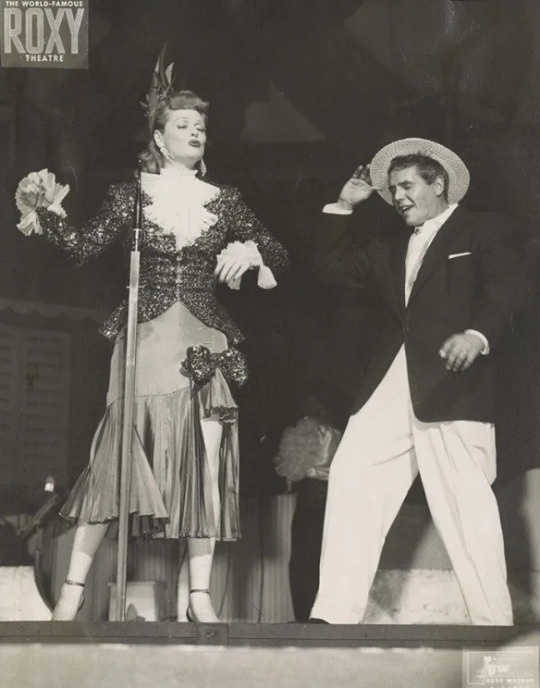
(17) The Tour incorporated some of the same routines seen in the “I Love Lucy” pilot as well as early episodes of the series, most notably the “Cuban Pete / Sally Sweet” duet. The tour culminated at the Roxy in New York City, where Desi was playing when he married Lucille in 1940.
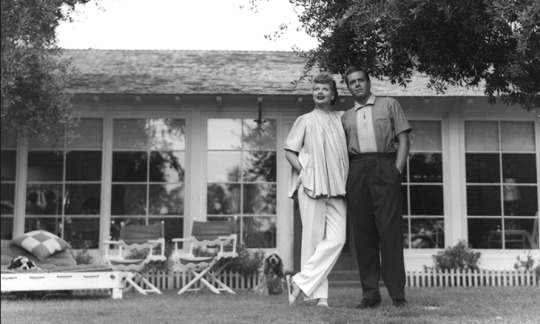
(18) Before moving to their Beverly Hills mansion, Lucy and Desi lived on a ranch in Chatsworth in San Fernando Valley. They dubbed their ranch home Desilu. About their neighbors:
Alan Ladd (1913-64) was a chorus boy when Lucille was an Earl Carroll showgirl in Murder at the Vanities (1934). He was married to Sue Carol (1906-82) from 1942 until his death. Carol’s name was mentioned on “I Love Lucy” in “The Fashion Show” when Lucy selects the same Don Loper original that Carol has chosen to wear in the fashion show. She does not appear on screen.
Francis Lederer (1899-2000) was a Hungarian-born actor. In 1960 he did an episode of Desilu’s “The Untouchables”. From 1941 until his death he was married to Marion Irvine.
Jackie Oakie (1903-78) did four films with Lucille Ball between 1934 and 1938, including both “Annabell” movies.
The Andrews Sisters were the pre-eliminant close-harmony girl group of their time. The consisted of Patty, Maxine, and LaVerne. They were mentioned on “I Love Lucy” in “Be a Pal” in the same scene that the photo at the top of the article came from. In 1969, Patty Andrews guest-starred as herself on “Here’s Lucy”. Lucy and Lucie played the other two Andrews sisters.
13 notes
·
View notes
Text
Possible Excerpt from Had Enough: The Dreamsight Remix
Summary, the tag to follow
Around half-past twelve someone stopped at the door with something heavy on wheels. When the door opened it was to a large cart full of sweets that Harry had absolutely no reference for.
“Anything off the trolley, dear?”
Despite having a really good omelet for breakfast, he was craving chocolate something fierce. Besides, this was Magic food. Who knew when he would be able to try this stuff again?!
Deciding that he could be picky about what he actually ate later, Harry got two of everything. If he didn’t want it then Ron might. Or maybe someone else would. It was eleven sickles and seven knuts.
Ron stared at the mound of candy Harry brought back and tipped onto the seats.
“You can’t possibly eat all that.” He gasped.
“Depends on how hungry I am. Take what you want, I’m craving chocolate.”
Ron shook his head, holding up a wrapped package that was vaguely square-shaped. Opening it revealed sandwiches, and opening one of those made both Harry Ron wrinkle their noses.
“This is Percy’s lunch.” He groaned. “Or George’s. They both love corned beef. My favorites are egg and cress or egg banjo.”
The Dursleys didn’t like either of those so Harry had never had them before, but he knew that people liked their eggs in various states of cooked, so he just nodded along.
“I had an omelet for breakfast.” Harry offered. “But like I said, take what you like.”
“Mum’s usually better about the sandwiches. I guess she was a bit more harried now that most of us are off to school. I can’t imagine what she’ll be like next year.”
“She seems nice.” Harry mused warily, wondering just how well the Weasleys could claim to know the Potters. Did they see him when he was younger like his parents’ other friends?
“She’s nice,” Ron emphasized. “But Fred and George have been on me about my first year, telling me all sorts of weird things. She’s been a bit more strained this year.”
“Well, older brothers are weird.” Harry snorted. “Sometimes they give you good advice, but sometimes they sit back and watch you flail.”
Better Jaime than Dudley, though.
Ron agreed with Harry’s sentiment and the pair worked their way through the pile of sweets. Ron liked the sticky stuff, like jelly beans and licorice. He explained various charms on certain snacks, like how some of the beans were flavored to taste like actual liver. Something he learned the hard way after spitting one out and taking a large swig of a water bottle Harry gave him.
The chocolate frogs moved. That scared Harry but once the chocolate hit his teeth it stopped. He wasn’t eating actual frogs dipped in chocolate, it was just an enchantment.
“What card did you get?” Ron asked.
“Card?” Harry asked. “What-?” He wrinkled the package and flipped it upside down. “Oh, you mean this?”
A small trading card that reminded him strongly of Jaime’s football cards fell into his palm.
“They’re famous Magicians,” Ron said. “I’ve got about five hundred but there are a few, in particular, I’m looking for. What’s yours say?”
Harry scanned the card and Dumbledore’s face looked back at him. This was the first time Harry saw even a picture of the man in the real world after seeing and hearing so much about him from the dreams. His nose definitely looked like it hadn’t been set straight, his hair and beard were longer than the card and a fine white, and his glasses sat on his nose in a way Harry could never get his to do. Probably because his were smaller. Did he need them to see regularly or if they were just reading glasses? Did Magicians have prescriptions or did everyone just fix their eyes?
“Dumbledore,” Harry said, wondering why the picture took up the whole front of the card. Flipping it over got him the words he was looking for.
“Albus Dumbledore, currently Headmaster of Hogwarts. Considered by many to be the greatest magician of modern times, Professor Dumbledore is particularly famous for his defeat of the dark magician Grindelwald in 1945, for the discovery of the twelve uses of dragon’s blood, and for his work on alchemy with his mentor, Nicholas Flamel. Professor Dumbledore enjoys chamber music and ten-pin bowling.”
The last part made Harry laugh. He wasn’t very good at bowling but there was an alley nearby and the Alfers took him enough that he could imagine this old man hurling a fourteen-pound ball down the slick lanes set up at an alley. Harry wondered if Dumbledore had a setup in that office of his.
“I haven’t got Agrippa yet!” Ron complained. Harry glanced up and saw that Ron was onto his fourth one. He had three cards to show for it and was happy to give them to his new friend. Harry tucked them into his pocket, resolving to look at them later. He tried another two, biting the heads off fiercely to still them, and saw Merlin and someone called Cliodna. They, too, went in his pockets. Ron grumbled about a green jelly bean that turned out to be a sprout of some kind and held out the bag, which was now a third of the way gone. Harry took several, picking through the colors that looked the most harmless and chewing slowly. They turned out to be toast, coconut, baked bean, strawberry, curry, grass, coffee, sardine, which reminded Harry of the smell of anchovies, and Ron gave him one that he’d eyed warily. Harry only sneezed at it because it was pepper.
The scenery changed from flat fields to a forest of green, winding rivers, and hills the height of the train.
Someone knocked on the door and Harry said “not yet.” as he shoved the empty candy wrappers into a pile on the floor and moved the rest onto the seat beside Ron.
“Come in,” He said.
Neville Longbottom had a circular head and wide grey eyes that were puffy with tears He wiped his face with his sleeve, robed in the black Hogwarts gown, and spoke.
“Have you seen a toad at all?” He asked. Harry and Ron both shook our heads.
“I’ve lost him!” Neville wailed. “He keeps slipping away!”
“Maybe it will help if you ask an older student to bring the toad to you.” Harry mused aloud.
“Bring Trevor… how would anyone do that?”
“There’s a way to summon things,” Harry muttered, now irritated that he didn’t remember the word. “Can’t remember it for anything. Sorry.”
“Thanks anyway. I’ll see if anyone else knows.”
Neville closed the door and Ron snorted.
“Don’t know why he’s so bothered.” Ron snickered. “If I’d brought a toad I’d lose it as quick as I could.”
“At least a toad’s on the pet list.” Harry ground out, glaring at Scabbers. The rat didn’t so much as twitch in Ron’s lap.
“Yeah, yeah, I can’t talk since I brought Scabbers,” Ron grumbled. He might have died and you wouldn’t know the difference.”
“You’d notice the smell eventually,” Harry offered darkly. This rat didn’t know just how much Harry wanted him to die.
“I tried to turn him yellow yesterday to make him more interesting but the spell didn’t work. Want to see?”
Harry nodded, hoping something bad would happen to the git instead.
Ron rifled through his trunk and yanked out a wand that was practically falling apart. It was chipped in places and something white glistened at the end. Upon seeing Harry’s face, Ron grimaced.
“Charlie’s old wand, remember? He’s second-oldest.”
Which meant that wand had seen seven years of use. Possibly more, with how battered it looked.
“Unicorn hair’s nearly poking out. Anyway-.”
“I’m not sure you should use that wand.” Harry offered quickly, going through his own bag and handing him the one he’d gotten from Ollivander. Ron took it reverently and with a stunned look on his face.
“What?” Harry asked, wondering if he’d done something wrong.
“People don’t give each other wands unless they’re family,” Ron explained. “A wand is an extension of yourself. I’m lucky enough that Charlie’s wand works on me, that’s the only reason I’ve got it. I… I can’t-.”
“I would rather you try something with that one than get hurt because you need a new wand, Ron. It’s just one try. Go on.”
Ron twitched his hand in a jerky manner and said what sounded like a nursery rhyme.
“Sunshine daisies, butter mellow, turn this stupid fat rat yellow.” He scowled.
Harry noticed that those were all yellow things, so if magic was about intent like some of the books he’d read insisted, there was a slight chance of it working.
The rat was still very much asleep and Harry couldn’t tell if his fur had changed.
“Are you sure that’s a real spell?” A new voice asked loudly. A girl in Hogwarts robes with bushy brown hair had opened the compartment door. Neville stood not far behind her.
“Intent plays a pretty big part in magic.” Harry found himself saying. “It could be the spell, it could be that he’s not using his own wand, it could be that the magic isn’t strong enough. One thing in the spell’s favor is that there are three things already yellow in it. Try again, Ron, but think of it this way: what would your rat look like if he were as bright as a dandelion?”
Ron nodded seriously and tried again. Scabbers’ fur took on a weird tinge that was more than the grey it usually was.
“Thanks, Harry.”
“Anyway, I was going to ask you what you meant when you told Neville about a summoning charm? He asked me about it but I don’t know what he’s talking about.”
“Which is why I said to find an older student. Why don’t I go with you? Ask the boy if he’d be okay sitting with my friend, Ron.”
Hermione stared at Harry with a stern look on her face but did it anyway. She and Neville came into the compartment and Neville introduced himself.
“Neville Longbottom,” He said gratefully. “Thanks for helping me find my toad.”
“Pets are wanderers.” Harry offered, not really knowing why he said that. “C’mon, you-.”
“Hermione Granger.”
“C’mon, Granger. We’re going to find an older student.”
“Why me and you? Neville’s the one who lost his toad.”
Because she was annoying Ron and Harry didn’t trust her and Neville not to get lost or distracted again. It was a lot better this way, not that she’d ever know.
“We’re more likely to get results.” Is all he said in response. Harry knocked on a random compartment and waited for a raspy “come in.” before opening it. Inside sat four kids, one of whom he’d met before.
“Hello, Hufflepuff.”
“Good day, Slytherin-wannabe.” Harry snorted. “Malfoy, right?”
“Yes. And you are?” The girl beside him scowled.
“Not important. Would any of you happen to know a way to summon things to you?”
“There’s a summoning charm.” The girl said. “My mother used it all the time when we packed for Hogwarts. Say Accio and imagine what you want. Mum says it’s got to be clear in your mind.”
“Thanks.”
“Say, Hufflepuff, you never gave us your name.”
“You’ll find out at the Sorting, won’t you?” Harry snorted.
“Sure, but-.”
“Friends call me Wolf,” Harry said. “We’ll see if you get that far after the Sorting.”
“I look forward to collecting on that debt.” Malfoy sneered.
“We’ll see about that, too.” Harry chirped knowingly. He had resolved to be in whatever House Hermione ended up in. Hopefully, that would be Gryffindor.
The compartment door shut behind them and Hermione tapped Harry’s shoulder as they started walking again.
“What was that?” She demanded.
“I met Malfoy at a robe shop. We bet on which House I’ll end up in because he’s so convinced he’ll be in Slytherin.”
“Well, why wouldn’t he?”
“Because he was gullible enough to take me up on that bet.” Harry deadpanned. “But he’s small potatoes. We need to find someone who knows the Summoning Charm.”
“That’d be me,” A familiar voice crowed.
“Or me.” An eerily similar one chirped. The Weasley twins had popped out of absolutely nowhere and Harry was lucky he didn’t flinch and hit one of them. He was getting better at that.
“Hey Fred, hi George.” He grinned at them both. “Follow me, we’re heading back to my compartment now.
“What could the ickle firsties need a Summoning Charm for?” Fred queried.
“We’re looking for a friend’s pet.”
“Ah, and who gave you the idea to use that spell?” George wondered.
“I remembered seeing it in a book I read but couldn’t remember the name.”
“That’s quite alright, my friend because we definitely do!” George offered. “What’s the toad’s name?”
“I guess we’ll find out once we get back to the compartment. That’s where our friends are.”
“Aw, has ickle Ronnie made a friend already?”
“He’s pretty cool,” Harry said defensively. “He turned his rat a bit yellow with that dud spell you gave him.”
“With Charlie’s wand?” Fred asked incredulously.
“God, no,” Harry scoffed. “I gave him mine. And he can keep it until we get to school.”
“No, he can’t.” George insisted.
“I’m the wand’s owner. I’m saying he can.”
“Because you don’t know how wands work. He’ll be giving it right back when we get to that compartment.”
“It’s my wand.”
“Exactly,” Fred said seriously. “And you don’t know how much it means to just give it away to some nobody.”
“Ron isn’t nobody!” Harry spat, yanking open the compartment door. “He wanted to try a spell and I thought it’d be better if he did it with something that wouldn’t poke our eyes out!”
“Alright,” George said suddenly. “It’s alright. You weren’t… wrong to give Ron your wand, but it’s not often done between strangers. A Magician’s wand is seen as an extension of the self. It’d be like chopping off a finger to lend to a friend.”
Bad comparison considering Scabbers was within hearing distance.
“Alright.” Harry snorted. “But it kind of worked. Now, can you do the Summoning Charm or not?”
“Of course What’s your toad’s name?”
“Trevor.” Neville stammered.
George took out his wand and at Fred’s nod, spoke the phrase:
“Accio Trevor the Toad.”
A sound not unlike the wind filled the train and when Fred stepped aside, Trevor came straight into Neville’s hands.
“Now, you should keep your toad on you.” Fred insisted. “Here,” The ginger twin held out an empty brown sack that Harry snagged from them with a grateful nod and tipped over. Nothing came out on his palm and Harry felt nothing but cloth when he stuck his hand in it. Harry passed it to Neville and he slipped Trevor into the bag and drew it semi-closed.
“What’s your name, kid?”
“Neville Longbottom.” Neville stammered out. “Thank you.”
“Anytime, Neville, good luck with your toad.” George offered.
The twins left and the four students settled into the seats in the compartment. Harry noticed the candy was gone, likely stuffed into a bag.
“What was all that about wands?” Hermione asked. “And did you honestly make a bet with another student?”
“I let Ron use my wand for a spell earlier. His brothers took exception to that.” Harry scowled. “It doesn’t matter as much to me, but they did. I just don’t think Ron should be using the wand he was given by his family.”
“Why?” Neville wondered. “My grandmother gave me my Dad’s wand. It works well enough for me.”
“Well, are you and your father exactly alike?”
“Gran sure hopes so.”
“Even identical twins, like Fred and George, aren’t. It’s good that your wands are compatible, but that’s probably because you’re family with the people who have already used it.”
“You sure are taking this seriously.” Ron noticed.
So Harry told him about the trip to Ollivander’s, about how it felt like a million wands to go through, about how the holly wands had been compatible but not exactly right, and Ollivander had insisted that Harry keep trying.
“I felt wretched after a huge pile of wands that didn’t work or barely produced a spark. You’ll be a lot better off with a wand that fits you.”
“Well, the spell worked with your wand. Who’s to say it wouldn’t have worked with Charlie’s?”
“I guess we aren’t to say.” Hermione offered. “But maybe the teachers at school can tell us. Speaking of spells, I’ve tried a few, just for practice, and they all worked for me. Nobody in my family is magic at all, so it was quite a shock to get an owl on our window!”
“I was lucky enough that my aunt knew something of it,” Harry admitted, glad he didn’t stutter over the not-quite-lie. “I honestly called it Hogwash when I first got the letter. Non-Magicians don’t know all this exists and I was no exception.”
“But you’re a magician.” Ron insisted.
“So’s Hermione. Doesn’t mean we knew about it beforehand.” He said.
“Fair enough. Say, Mum said she and Dad knew your family, but you never did say your last name.”
“It’s bad enough you know my first name. Just call me Wolf. Everyone will if I have any say on it.”
“Can we guess?”
“If you want. Harry is a common name.”
“Sure is, but you underestimate how few kids there are this year.” Neville offered.
“Why’s that?” Harry asked, wondering how much of this would match up with the dreams he’d been having.
“Goodness, you don’t know?” Hermione gasped. “The Magicians had a war amongst themselves. It’s in every book I could get my hands on. There was this Dark Lord everyone calls You-Know-Who and he came out of basically nowhere and was all anti-humans and so the Magical World split itself up into his followers and his opponents. Apparently, he was defeated by a couple of young Magicians who left behind their baby boy. Now the kid’s known as the Boy-Who-Lived so he and his parents are celebrated every Halloween.”
“Why Halloween?” Harry prompted knowingly.
“Because that’s when they died,” Neville mumbled.
At least some parts of the story changed.
“It’s in Modern Magical History, The Rise and Fall of the Dark Arts, and Great Magical Events of the Twentieth Century,” Hermione reported.
“I’ll pick those up, I guess.” Harry offered, kind of interested now. “What did they do?”
“Who?”
“The young Magicians. What did they do for a living?”
“You mean once they got out of school? They fought in the war.” Neville said. “They knew my parents rather well, or so my grandmother says.”
“Do you think they got a chance to do anything once they got out of school?” Harry asked. “What is there to do once you get out of school?”
“Well… I don’t think so.” Ron offered. “My Mum and Dad fought against You-Know-Who as well, and Dad said he got his job at the Ministry after the war.”
“Huh,” Harry said, a bit shocked.
“As for what there is to do, my two oldest brothers are Bill and Charlie. Charlie handles dragons in Romania-.”
“Okay, that is so cool.” Harry blurted out.
“And Bill’s in Africa doing something for one of the Gringotts branches there.”
“Where?”
“What?”
“Where in Africa? That’s a whole continent. It’d be like saying ‘Oh, he lives in Europe.’ as opposed to saying Spain or Italy.”
“Fair enough. I think he does work in Egypt. There’s a lot of stuff Magical stuff in Egypt. It’s only fair that Gringotts would want to know what.”
“Speaking of Gringotts,” Neville spoke suddenly. “You guys haven’t gone there too recently, have you?”
“I went about a month ago.” Harry offered. “McGonagall took me.”
Hermione confirmed the same and Ron said that his father went before Harry and the Alfers did.
“What’s got you so spooked?” Harry asked.
“Someone tried to rob a high-security vault,” Ron announced.
“At Gringotts?” Harry coughed. “The bank full of non-human magical creatures, mostly elves, and no one gets in or out unless they say so?”
“There’s more than just elves,” Hermione said suddenly. “I saw dwarves as well.”
“Cool. What happened to the unlucky bastard who tried to pull that off?”
“Nothing. Nobody got caught. My dad says they must have been a powerful Dark Magician to pull that off, but there wasn’t any mention of what was stolen.”
“Perhaps Gringotts is trying to investigate for themselves.” Hermione offered. “I know that regular banks do that. They work with the police sometimes.”
“Maybe.” Ron agreed. “But everyone wants to know. They’re all scared when something big happens since it could be related to You-Know-Who.”
“Related to the guy who was defeated by two Magicians fresh out of school and maybe half his age?” Harry drawled.
“Well, no one knows where he went.” Ron insisted defensively. “And if it’s all the same to you, I’d rather not find out.”
We would if Voldemort was Quirrell. But Harry couldn’t tell them that.
“What’s your Quidditch team?” Ron prompted in an obvious attempt to change the subject.
“What’s Quidditch?” Hermione asked.
Ron burst into a rousing speech of the game played on broomsticks. It was a long explanation of how seven players hauled four balls between them. Ron talked about everything he knew, from famous games to games he’d been to and the most coveted broomsticks of the year.
Neville inserted a few of his own opinions and eventually, the boys were debating the best teams while Harry and Hermione stared at them. She was likely just as confused as Harry was. He’d seen some things about Quidditch in his dreams and dream-Harry had definitely liked the sport, but Harry was a bit too focused on all the tragedies happening around him to focus on the school’s sport.
A voice echoed through the train, calling ten minutes to Hogwarts and not to worry about their bags. Ron and Neville jerked to their feet mid-argument.
“C’mon, Wolf, let’s let Hermione change, and then we’ll get changed.” Ron offered, dragging Neville and Harry out of the compartment without so much as missing a beat in his explanation of why the Chudley Canons might go onto the Quidditch World Cup in three years.
When Hermione was done, they switched places, with her waiting just outside the compartment as Neville showed Harry and Ron how to wear their robes properly.
The robes draped down to Harry’s feet and Ron’s almost did the same.
The train eventually stopped and the four of them were swept along with the crowd that pushed off the train and onto a small nearly pitch-black platform. Harry fought the urge to shiver, wishing he’d gotten Jaime to tell him the heating charm people used on their clothes. He’d find it in some books, he was sure, but it would be extremely useful now.
A lamp bounced up and down like a tight-knit group of fireflies above our heads, cutting through some of the gloom. With it came a large booming voice.
“First-years, this way!” A man’s roar parted the crowd like the Red Sea. “First-years follow me!”
The path was slick with mossy water, steep and narrow enough that we had to file after the large man one-by-one. Harry was honestly surprised that the man, who must be Hagrid based on his massive stature and gruff-growly voice, was able to keep his balance as he guided them up what felt like a mountain. Rock-climbing at the nearby gym had offered Harry enough chances that he could say with complete honesty that they were definitely climbing a mountain.
It was just as steep and narrow with just as many chances to fall and send everyone tumbling down before or after him. What’s worse is that they stumbled forward in complete darkness. Harry had to rely on his sense of direction, which was practically nothing, to make sure he wasn’t bumping into anyone. Luckily, the people around him were people he figured wouldn’t be too terrible about his flailing. He hoped.
“Hogwarts School of Magic coming right up!” Hagrid called eagerly. “Just around the bend here!”
Sure enough, the kids who were further ahead were shouting in excitement. When the kids closest to Harry got to the end of the path, everyone stood before a large black lake that, if it weren’t for the occasional ripple, he wouldn’t be able to tell the water from the inky darkness. What he could tell is that he was right about being in the mountains.
On the other side of the lake, a lot higher than where he stood now was a massive spanning castle. Its windows sparkled like glittering eyes among the darkness and for each ground-level window was a string of lights higher than he could crane his neck. The outline of the castle followed shortly after, once his eyes adjusted, revealing that some of the glittering lights were indeed the stars above the windows.
“No more than four to a boat!” Hagrid called, jerking Harry out of his stupor. He swung the lantern toward a fleet of small boats sitting in the water by the shore. Ron, Neville, Hermione, and Harry went to a boat. Hagrid swept through the crowd to make sure everyone got to a boat and bellowed for the boats to move.
And move they did. Harry knows magic has to have a lot of intent behind it but does this work on anyone? Could he move the boats if he knew the words? Was it a job only for Hagrid? Because these were a lot of boats and since Hagrid is pretty big, Harry bet he could do it but-.
“That’s a lot of questions, Wolf.” Neville offered, wide-eyed. “With a mind like that, you’ll get into Ravenclaw for sure.”
It doesn’t matter what House he gets into. He’ll be doing enough exploring to know them all. He couldn’t afford to miss something just because he was too wrapped up in what he thought he knew.
“Heads down!” Hagrid’s voice carried well over the water and Harry ducked instinctively, as did the other three.
They were sailing along the face of a giant cliff and the reason they were told to duck is to go through it, a tunnel introduced by a curtain of ivy. The tunnel was just as dark as the steep mossy mountain-path that had brought the students to the boats and the way things echoed made him think they were underground. The boat ride ended underground as well, and Harry followed the others on a passageway that was seemingly carved from the cliffside.
The students walked for a while, with the only thing Harry could see ahead being Hagrid’s lamp until his feet met damp flattened grass of a courtyard in the shadow of the castle. Finally, they reached the door, a tall solid sprawling tree of a thing that rumbled against Harry’s feet when Hagrid knocked on it.
2 notes
·
View notes
Text
Eddy x Florence slow-burn collection: What, No Cigarettes? (1945), Wall Street Blues (1946)
"You're too fat!" & "Shut up": Fish Feathers (1932), Brick-A-Brac (1935), Two for the Money (1942), Sock Me to Sleep (1935), Radio Rampage (1944), Wall Street Blues (1946)
Tender moments: Sock Me to Sleep (1935), Ears of Experience (1938), Love on a Ladder (1934), Rough on Rents (1942), What, No Cigarettes? (1945), In-Laws Are Out (1934), The Big Beef (1945), Two for the Money (1942)
Eddy, mother-in-law and brother-in-law: Duck Soup (1942), Edgar Hamlet (1935)
Jeanie With The Light Brown Hair: Social Terrors (1946). Sung by Edgar Kennedy, his wife(Florence Lake), his mother-in-law(Dot Farley), his brother-in-law(Jack Rice), his brother-in-law's sweetheart(Phyllis Kennedy) and his brother-in-law's sweetheart's parents(Paul Maxey, Vivien Oakland).
#edgar kennedy#florence lake#what no cigarettes? 1945#wall street blues 1946#fish feathers 1932#brick-a-brac 1935#two for the money 1942#sock me to sleep 1935#radio rampage 1944#ears of experience 1938#love on a ladder 1934#rough on rents 1942#in-laws are out 1934#the big beef 1945#duck soup 1942#edgar hamlet 1935#social terrors 1946#dot farley#jack rice#phyllis kennedy#paul maxey#vivien oakland
0 notes
Text
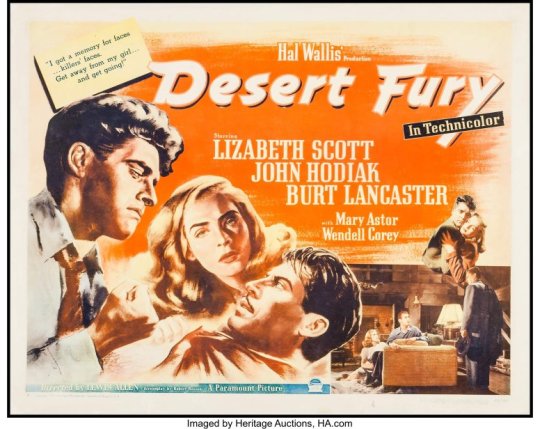
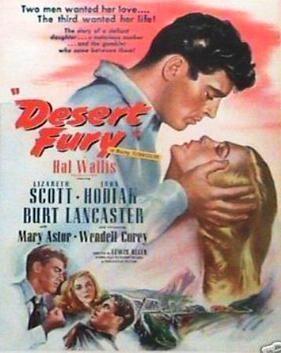
Burt Lancaster got his contract with Hal B. Wallis at Paramount on the basis of a test directed by Byron Haskin with Wendell Corey and Lizabeth Scott for Desert Fury. Lucky for him, the film was not ready to shoot for another six months and he was able to fit in Robert Siodmak’s The Killers(1946) for producer Mark Hallinger at Universal beforehand. Desert Fury started shooting two weeks before the release of The Killers but there were already whisperings of Lancaster as a big new star, and the whisperings were so loud that Hallinger gave him first billing and a big publicity build-up rather than the little ‘and introducing….’ title at the end of the credits that was then typical, and is indeed the billing offered Wendell Corey in Desert Fury as you can see in the poster above. Before Desert Fury started shooting, Hal Wallis knew he had a big fat star on his hands and that his part had to be beefed up so as to capitalise on it.
By the time the film was released on September 24th, 1947,, Burt Lancaster was the biggest star in the film. The Killers hit screens on the 29th of August 1946. As Kate Buford writes, Ít was an extraordinary debut for a complete unknown. Overnight he was a star with a meteoric rise ¨faster than Gable´s, Garbo´s or Lana Turner,¨as Cosmopolitan said years later (Buford, loc 1260). In New York the movie, ‘played twenty-four hours a day at the Winter Garden theatre, ‘where over 120,000 picture-goers filled the 1,300 seat theatre in the first two weeks, figures Variety called “unbelievably sensational.”‘ Brute Force was the fourth film Lancaster made, after I Walk Alone, but it was the second to be released, on June 30th 1947. According to Kate Buford, it too ‘set set first-week records at movie houses across the country’ (loc 1412).
Lancaster’s status as a star is reflected in the lobby card and poster above, where in spite of being billed third, what´s being sold is what Burt Lancaster already represented, the publicity materials giving a false impression that he is much more central to the narrative than is in fact the case. His image dominates in both, and even the tag lines are attributed to him: ‘I got a memory for faces…killer´s faces…Get away from my girl…and get going’, is the tagline in the lobby card. The text on the poster reads, ´Two men wanted her love…the third wanted her life.
In the ad below, he´s billed second, as ´the sensation of The Killers, Dynamite with the fuse lit’

When trying to recapture a past moment in relation to cinema, it´s often useful to look at trailers and other paratextual publicity materials. Trailers hold and try to disseminate the film´s promise to viewers. Of course, its purpose is to sell, to dramatise its attractions so that viewers will go see it. And of course, they often lie, dramatising not what is but what they hope will sell. That said, those promises, lies and hopes are often very revealing.
youtube
As you can see above, the trailer is selling melodrama — violent passions — in a magnificent natural setting filmed in Technicolor. Burt Lancaster’s name is only mentioned 39 second into the 1.41 trailer, after Lizabeth Scott with her strangeness and her defiance of convention and after John Hodiak with his secrets and coiled snakeyness. And Lancaster’s introduced as ‘hammer fisted’ Tom Hanson, erroneously giving the impression that this will be an action film. But note too that by the end of the trailer, Lancaster is given top billing.
According to Kate Buford, in Burt Lancaster: An American Life, Lancaster thought ‘Desert Fury would not have lunched anybody’, later ‘dismissing it as having ‘starred a station wagon’ (loc 1157). The film is really a series of triangles: Eddie (John Hodiak) and Tom (Burt Lancaster) are both in love with Paula (Lizabeth Scott), Fritzy (Mary Astor) has already had an affair with Tom who is currently pursuing an affair with her daughter Paula, Paula and Johnny (Wendell Corey) are both in love with Eddie etc. I have made a not-quite-video essay that nonetheless well illustrates the Johnny-Eddie-Paula triangle, surely one of the queerest of the classic period, which can be seen here:
Tom is really a fifth wheel in the narrative. But by the time the film started shooting, Burt Lancaster was already the biggest star in it. His part was beefed up to take his new status into account, scenes were added, According to Gary Fishgall, the film was based on a 1945 novel, Desert Town by Ramona Stewart, and ‘ Lancaster’s role was an amalgam of two of the novel’s characters: the embittered, sadistic deputy sheriff, Tom Hansen, and a likeable highway patrolman named Luke Sheridan. Neither character was romantically linked to Paula (p.55). But in the film, he ends up with Lizabeth Scott at the end. All these additions probably contributed to the film seeming so structurally disjointed.
In Desert Fury Tom, a former rodeo rider, just hangs around waiting for Paula to get wise to Eddie, leaving her enough rope to act freely, as he does with colts when taming them, but not enough so that she hangs herself, or so he thinks. Really, he’s extraneous. He gets to walk into the sunset with Paula at the end of the film but the film really ends once Paula and Fritzy kiss, on the lips. He certainly doesn’t get much to do during it, except for a couple of great scenes where Fritzy tries to buy him into marrying her daughter (above) and another bit of banter when she thinks he’s come to accept her offer (below). Mary Astor steals both scenes. In fact she steals everything. Every time she appears, her wit, weariness, intelligence, the intensity of her love for her daughter — she lifts the film to a level it probably doesn’t deserve to be in. But Lancaster is good. These are the only scenes in the film where he looks like he’s enjoying himself.
Tom is the closest the film has to a ´normal character’. Indeed, aside from the character he plays in All My Sons (1948) this is the closest he’d come to such a type during the whole of his period in film noir in the late 40s and which includes all of his films up to The Flame and the Arrow in 1950. Even in Variety Girl, which is an all-star comedy where he and Lizabeth Scott spoof the hardboiled characters they’re associated with, the surprise is that they’ve already created personas to spoof in such a short time (see below).
According to Fishgall, ‘Lancaster –billed third before the film’s title — acquitted himself well in the essentially thankless other man’ role. Still, if Desert Fury had marked his screen debut as originally planned, it is unlikely that he would have achieved stardom quite so quickly. Not only did the film lack the stylish impact of The Killers, but so did the actor. Without the smouldering intensity of the Swede and his first pictures’ moody black and white photography, he appeared to be more of a regular fellow, and guy-next-door types rarely become overnight sensations’ (p. 67).
In Desert Fury we’re told that unlike the drugstore cowboys who are now criticising him, Tom used to be the best rodeo rider there was but a while back, whilst wrestling a steer, he got thrown off and is now all busted up inside. Being ‘busted up inside’ is what all the characters Burt Lancaster plays in the late ’40s have in common. He thinks of returning to the rodeo all the time but knows he can never be as good. He used to be a champ, now all he can hope for is to be second best. He knows he ‘ain’t got what it takes anymore’. He’s in love with Paula and she knows it. But she doesn’t know what she wants. He think he does: ‘you’re looking for what I used to get when I rode in the rodeo. The kick of having people say “that’s a mighty special person” I’d like to get that kick again. Maybe I can get it with just one person saying it’. He will, but he’ll have to wait until the end of the movie.

But even in this, Lancaster doesn´t play entirely nicey-poo, true-blue, throughout, and his Tom is given moments of wanton bullying and cruelty where he gets to abuse Eddie just because he’s a cop and wants to. And it´s interesting that it´s that moment, which jives so well with the ´brute force´Lancaster was already known for, and which would attach itself to his persona for many a year, that is the one chosen for the trailer.
According to Robyn Karney, in Burt Lancaster: A Singular Man, ‘As the straightforward moral law officer in a small Arizona town who rescues the object of his affections from the dangerous clutches of a murderous professional gambler, Burt had little to do other than look strong, handsome and reliable. Despite Wallis’ much vaunted rewrites, the role of the Sheriff Tom Hanson remained stubbornly secondary and uninteresting, with the limelight focused on John Hodiak as the villain, fellow contract players Elizabeth Scott and Wendell Corey’ (p.31).
I mainly agree with Robyn Karney except for four points, two textual and stated above: the first is that even in this Lancaster is playing a failure, someone once a somebody that people talked about but now all busted up inside; the second is that that element of being ´busted up inside´leads to a longing that gets displaced onto Paula. If the rodeo is what made feel alive and gave him a reason to live before his accident, now it´s Paula, and the idea that she might also be an unobtainable goal leads to his outbursts of unprovoked violence towards the rival for his affections, Eddie (John Hodiak).
The other two points of interest are extra textual. Desert Fury is gloriously filmed by Charles Lang. A few years later, in Rope of Fury, Lang would film Lancaster as a beauty queen: eyelashes, shadows and smoke, lips and hair (see below):
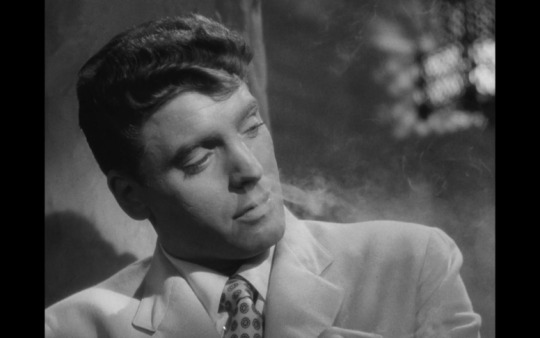
Here, even with his pre-stardom teeth and his bird´s nest of a hairdo, Lancaster sets the prototype for the Malboro Man:

He looks good in technicolour, and Lang brings out the blue of his eyes:
More importantly, the film visualises him, for the first time, as Wester Hero, a genre that would become a mainstay of his career from Vengeance Valley (1951) right through Ulzana´s Raid (1972) and even onto Cattle Annie and Little Britches (1981):

Desert Fury was not well reviewed. According to the Daily Herald ‘The acting is first-class. But except for Mr. Lancaster as a speed cop, the characters in the Arizona town with their lavish clothes and luxury roadsters, are contemptible to the point of being more than slightly nauseating’ (cited in Hunter p. 27),
The Monthly Film Bulletin labelled the film a western melodrama, claiming, surprisingly, that ‘The vivid technicolor and grand stretches of burning Arizona desert give a certain air of reality to the film’. Hard for us to see this thrillingly melodramatic film, lurid, in every aspect, evaluated in the light of realism. The MFB continued with, ´This reality is however counteracted by the way in which the sharply defined, but extremely unnatural characters act. Everything is over dramatised, and the title is a mystery in that the desert is comparatively peaceful compared with the way the human beings behaved…Lizabeth Scott is suitably beautiful as Paula and Burt Lancaster suitably tough as Tom. (Jan 1, 1947, p. 139)
Thus, we can see that on the evidence above, the film was badly reviewed, Time magazine going so far as to call it, ‘impossible to take with a straight face’ (Buford, loc1293). But Burt Lancaster´s performance was either exempted from the criticism or its faults where attributed to the film rather than to himself. More importantly still, the film was a hit, Burt Lancaster´s third in a row. Finally, as I´ve discussed elsewhere, the film is now considered by many a kind of camp classic, a leading example of noir in technicolor as well as arguably the gayest film ever produced in the classic period.
José Arroyo
Burt Lancaster in Desert Fury: Third Film, Fifth Wheel Burt Lancaster got his contract with Hal B. Wallis at Paramount on the basis of a test directed by Byron Haskin with Wendell Corey and Lizabeth Scott for…
#Burt Lancaster#Desert Fury#Lewis Allen#Lizabeth Scott#melodrama#noir#post-war cinema#post-war stardom#stardom#Third Film Fifth Wheel#westerns
4 notes
·
View notes
Link
How about a little background. I'm from the wrong side of the tracks. My siblings would have stolen railroad tracks and sold them for scrap. When we left the farm, we went to the trailer park. The trailer park was, naturally, on the wrong side of the tracks. I wore hand-me-downs and Goodwill clothing. I was a high school dropout who moved out at 15. So I'd seen the bad side of living in the US. I remember my dad sending me in to buy 10 cent candy with a $1 foodstamp so I could give him the change. We did that till he had enough gas in the car to take me to school and he could get to whatever job he had at the time. Or to buy booze. Whatever. So, I'd seen the bad part. It wasn't fun. I enlisted, and the Army was great. When you lived in a trailer with a leaky roof and shoddy electrical and drove a car that you epoxied the passenger door shut, and went to bed hungry on the four days before payday, well, the Army is the fucking life. I went to Europe. Assigned to West Germany. I liked it. Then the Wall fell. Now, West Germany was a modern nation. Luxuries everywhere. Plenty of food. In accordance to the independent streak I still had, I had moved out onto the economy as soon as S2 gave me permission. I wasn't a barracks rat. There were places to see and people to fist fight. When I went into East Germany, I saw East Germany through my own biases and colored by my personal experiences. And I was suddenly glad that I was born on the wrong side of the tracks in America. That girl I mentioned? I knew she was only fucking me to get access to the PX and maybe hoping I'd take her back to the US with me. (Hah, those titties may have been like POW! and that ass may have been like BLAM! but I ain't taking you home) I didn't care. Don't look down on her. Don't you fucking dare. She was East German. Her father had been taken away when she was a kid and she never saw him again. She had grown up, many times, without heat, without food, without decent fucking clothing. She sat on my couch in my little apartment looking at my photo album and asked me what my parents did that we were so rich. My family. She knew what it was like to not have heat in the winter, or have the roof leak, or be evicted from her home. Only it was different. We were evicted because booze was more important than rent. Her family was evicted for 'reasons' she didn't know. Just it was after her brother got arrested and vanished. Like father, like son. Touring East Germany was like touring one big trailer park. The factory parking lots full of rusting junk? Yeah, seen that. I asked what was being made. She just shrugged. They weren't allowed to know. She worked there. I met her neighbors. I listened to them. They told me things about living in Communist East Germany. Learned to hate the Stasi just like they did even though they had vanished into the dustbin of history. Well, were being swept away. I knew about police brutality and excess from being poor white trash. Nobody will kick your ass in the interrogation room like a cop who knows your family can't afford a lawyer. But they aren't allowed to kill you. Not so with the Stasi and the rest. The apartments made me sad. Her apartment made me sad. I had more room and better living conditions in a Cold War Era barracks on top of a frozen fucking mountain than she had grown up in. If I didn't pay my power bill, they turned off the power. Her power was turned off, apparently for shits and giggles. Just random fucking times. She told me, and her mother told me, that it was better now than it was before the Wall fell. The power was on more often than it wasn't. The architecture was brutal, simplistic, dehumanizing, and above all, trailer trash cheap. The concrete was crumbly, the windows had gaps, all of it was shit condition. The trailer I'd moved in to for $50/mo when I'd first left home was better than that block style apartment building. My high school dropout in and out of juvie white trash ass had it better than everyone in her building. Bags of potatoes at the Commisary were $2.50 a 50 lb bag. We're talking half of what I spent on a quad-151 and coke with 2 cherries for a 50 lb bag of fucking potatoes. Well, for her birthday I bought some groceries at the Commissary. Nothing major. I wanted to make corn beef and cabbage stew for her. I spent like $30 at the Commissary. Nothing major. I mean, that's like 1 night of drinking cheap well whiskey. (Yes, I used to measure my expenditures by how much booze I could swill down for the same price. Like father like son) The next internet commie who tells you that food was plentiful in the 1980's in Communist East Germany, feel free to beat with a sack of cheap potatoes. Maybe in the city, but I liked my girls from the country. And it was a small town built to support a factory that everyone was forcibly relocated there in the 1960's. Ever been embarrassed by someone's reaction to something you take for granted. See, in the US, corned beef, cabbage, potatoes, all of that is 'poor people food'. Shit you learn to make on the wrong side of the tracks because it makes a lot, cheaply, and keeps for a few days. THeir reactions still embarrass me to think about. I was a farm boy originally before we ended up in the trailer park. "It's just basic food..." went through my head at one point. I'm Irish descent. Potato, butter, and beer, and I'm good. Her grandmother accused me of trying to buy her. Yelled at me till I left. I sat on the curb, trying to figure out just what the fuck happened, when her mother came out, called me a good boy, and had me come back inside. Grandma apparently had a flashback to when political officers would bribe families with food like that and then take the daughters. And that was when things had gotten better and the Fabulous Stalin Rape Fest of 1945-1952 was over. But sitting there, looking around, smoking a cigarette, I saw that while it was just as bad as the trailer park, I mean, it WAS a factory town, the people did their best to make it into home. They hadn't given up. There was faded colors here and there on that shitty cement. The curtains were bright and decorative. Little flower gardens here and there. There were some kids kicking a ball. But it "felt" different. If you're from the bad side of the tracks, you'll understand this... Sitting there, in the sunlight, smoking a cigarette, the Wall is down, the USSR is losing its grip, there had been a riot that took out the Stasi headquarters in Dresden, but there's a certain feeling. It felt like it did in the trailer park when a half dozen cop cars pull in, blocking off the way in & the way out. That few seconds before the cops get out of the cars looking for a "person of interest". There was nothing to really cause it, not that day, but it was still there. And there was this "gray" feeling to things I guess, that went along with that subtle feeling of dread. I got it, sitting there. Knowing that you're powerless against the State. That the powerful can do whatever the fuck they want to you and nobody will care. Hell, they'll be glad it isn't them if they don't snitch to avoid being looked at too close. It was Communism that had pushed them this far. That had taken the German people, who only had 43 years of difference between their Western counterparts, and done that to them. No beer fests. No fests no pay phone on the corner, no corner butcher, no store full of food, none of that. It had all been robbed from them in the name of collectivism. All funneled toward Moscow and the powerful. No checks and balances. No "equal before the law" that the US at least gave lip service to when someone might be looking. The whole fucking country was the wrong side of the tracks. That's Communism. Dividing a country in half * turning half of it into a goddamn trailer park. Worse than a trailer park. Compared to them, I was lucky. And that makes me mad. /fin
https://twitter.com/TWillardAuthor/status/1074214723711889409
135 notes
·
View notes
Video
youtube
THE MONOPOLIZATION OF AMERICA: The Biggest Economic Problem You’re Hearing Almost Nothing About
Not long ago I visited some farmers in Missouri whose profits are disappearing. Why? Monsanto alone owns the key genetic traits to more than 90 percent of the soybeans planted by farmers in the United States, and 80 percent of the corn. Which means Monsanto can charge farmers much higher prices.
Farmers are getting squeezed from the other side, too, because the food processors they sell their produce to are also consolidating into mega companies that have so much market power they can cut the prices they pay to farmers.
This doesn’t mean lower food prices to you. It means more profits to the monopolists.
Monopolies All Around
America used to have antitrust laws that stopped corporations from monopolizing markets, and often broke up the biggest culprits. No longer. It’s a hidden upward redistribution of money and power from the majority of Americans to corporate executives and wealthy shareholders.
You may think you have lots of choices, but take a closer look:
1. The four largest food companies control 82 percent of beef packing, 85 percent of soybean processing, 63 percent of pork packing, and 53 percent of chicken processing.
2. There are many brands of toothpaste, but 70 percent of all of it comes from just two companies.
3. You may think you have your choice of sunglasses, but they’re almost all from one company: Luxottica -- which also owns nearly all the eyeglass retail outlets.
4. Practically every plastic hanger in America is now made by one company, Mainetti.
5. What brand of cat food should you buy? Looks like lots of brands but behind them are basically just two companies.
6. What about your pharmaceuticals? Yes, you can get low-cost generic versions. But drug companies are in effect paying the makers of generic drugs to delay cheaper versions. Such “pay for delay” agreements are illegal in other advanced economies, but antitrust enforcement hasn’t laid a finger on them in America. They cost you and me an estimated $3.5 billion a year.
7. You think your health insurance will cover the costs? Health insurers are consolidating, too. Which is one reason your health insurance premiums, copayments, and deductibles are soaring.
8. You think you have a lot of options for booking discount airline tickets and hotels online? Think again. You have only two. Expedia merged with Orbitz, so that’s one company. And then there’s Priceline.
9. How about your cable and Internet service? Basically just four companies (and two of them just announced they’re going to merge).
Why the Monopolization of America is a Huge Problem
The problem with all this consolidation into a handful of giant firms is they don’t have to compete. Which means they can -- and do -- jack up your prices.
Such consolidation keeps down wages. Workers with less choice of whom to work for have a harder time getting a raise. When local labor markets are dominated by one major big box retailer, or one grocery chain, for example, those firms essentially set wage rates for the area.
These massive corporations also have a lot of political clout. That’s one reason they’re consolidating: Power.
Antitrust laws were supposed to stop what’s been going on. But today, they’re almost a dead letter. This hurts you.
We’ve Forgotten History
The first antitrust law came in 1890 when Senator John Sherman responded to public anger about the economic and political power of the huge railroad, steel, telegraph, and oil cartels – then called “trusts” -- that were essentially running America.
A handful of corporate chieftains known as “robber barons” presided over all this – collecting great riches at the expense of workers who toiled long hours often in dangerous conditions for little pay. Corporations gouged consumers and corrupted politics.
Then in 1901, progressive reformer Teddy Roosevelt became president. By this time, the American public was demanding action.
In his first message to Congress in December 1901, only two months after assuming the presidency, Roosevelt warned, “There is a widespread conviction in the minds of the American people that the great corporations known as the trusts are in certain of their features and tendencies hurtful to the general welfare.”
Roosevelt used the Sherman Antitrust Act to go after the Northern Securities Company, a giant railroad trust run by J. P. Morgan, the nation’s most powerful businessman. The U.S. Supreme Court backed Roosevelt and ordered the company dismantled.
In 1911, John D. Rockefeller’s Standard Oil Trust was broken up, too. But in its decision, the Supreme Court effectively altered the Sherman Act, saying that monopolistic restraints of trade were objectionable if they were “unreasonable” -- and that determination was to be made by the courts. What was an unreasonable restraint of trade?
In the presidential election of 1912, Roosevelt, running again for president but this time as a third party candidate, said he would allow some concentration of industries where there were economic efficiencies due to large scale. He’d then he’d have experts regulate these large corporations for the public benefit.
Woodrow Wilson, who ended up winning the election, and his adviser Louis Brandeis, took a different view. They didn’t think regulation would work, and thought all monopolies should be broken up.
For the next 65 years, both views dominated. We had strong antitrust enforcement along with regulations that held big corporations in check.
Most big mergers were prohibited. Even large size was thought to be a problem. In 1945, in the case of United States v. Alcoa (1945), the Supreme Court ruled that even though Alcoa hadn’t pursued a monopoly, it had become one by becoming so large that it was guilty of violating the Sherman Act.
What Happened to Antitrust?
All this changed in the 1980s, after Robert Bork -- who, incidentally, I studied antitrust law with at Yale Law School, and then worked for when he became Solicitor General under President Ford – wrote an influential book called The Antitrust Paradox, which argued that the sole purpose of the Sherman Act is consumer welfare.
Bork argued that mergers and large size almost always create efficiencies that bring down prices, and therefore should be legal. Bork’s ideas were consistent with the conservative Chicago School of Economics, and found a ready audience in the Reagan White House.
Bork was wrong. But since then, even under Democratic administrations, antitrust has all but disappeared.
The Monopolization of High Tech
We’re seeing declining competition even in cutting-edge, high-tech industries.
In the new economy, information and ideas are the most valuable forms of property. This is where the money is.
We haven’t seen concentration on this scale ever before.
Google and Facebook are now the first stops for many Americans seeking news. Meanwhile, Amazon is now the first stop for more than a half of American consumers seeking to buy anything. Talk about power.
Contrary to the conventional view of an American economy bubbling with innovative small companies, the reality is quite different. The rate at which new businesses have formed in the United States has slowed markedly since the late 1970s.
Big Tech’s sweeping patents, standard platforms, fleets of lawyers to litigate against potential rivals, and armies of lobbyists have created formidable barriers to new entrants. Google’s search engine is so dominant, “Google” has become a verb.
The European Union filed formal antitrust charges against Google, accusing it of forcing search engine users into its own shopping platforms. And last June, it fined Google a record $2.7 billion.
But not in America.
It’s Time to Revive Antitrust
Economic and political power cannot be separated because dominant corporations gain political influence over how markets are organized, maintained, and enforced -- which enlarges their economic power further.
One of the original goals of the antitrust laws was to prevent this.
Big Tech — along with the drug, insurance, agriculture, and financial giants — is coming to dominate both our economy and our politics.
There’s only one answer: It is time to revive antitrust.
686 notes
·
View notes
Text

In my Mac Room lesson I've decided to make a propaganda moral poster for the SS voyager, the cosmic sailor of the galaxy, drifting endlessly alone for eternity in search of a new world to call home, basically planning to make my design like a 1945 German poster, with the red, black and white and have some big bold fancy text that says "STRONGER TOGETHER" I would imagine on my vessel that the moral is low and people are sick of the same food for the poor (This would be easy growing food such as Carrot's, potatoes, bugs and mushroom's) this would be like the movie snow piercer but in space...
On my poster there will be a retro looking astronaut worker looking out in the sunset, the poster will be asking for workers around the ship, such as sewage maintenance, solar panel maintenance, farming, interior police or a soldier for the US side of the ship.
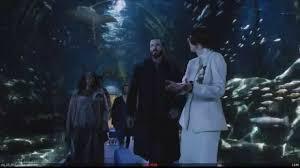
Ship separated into the rich and poor, rich eating more rare foods such as beef, chicken, salmon and fruits.
0 notes
Text
OLD GOLD COMEDY THEATRE
“A GIRL, A GUY, AND A GOB” ~ February 11, 1945

The Old Gold Comedy Theatre (aka Harold Lloyd Comedy Theatre) was NBC Radio’s attempt to replicate the success of CBS’ Lux Radio Theatre. It debuted on October 29th, 1944. Silent film star and producer (and Lucille Ball’s mentor) Harold Lloyd introduced condensations of movie comedies. This film happened to be one of his own. NBC programmed the series Sunday nights at 10:30PM for east coast audiences. The series was cancelled on June 10th, 1945.

Lucille Ball had done the second episode of the series, starring in Ball of Fire on November 5, 1944. Ball took the role originated in the 1941 film by Barbara Stanwyck while Cary Grant reprised his role for radio.

A Girl, a Guy and a Gob is a 1941 RKO film produced by Harold Lloyd and starring Lucille Ball, George Murphy, and Edmond O'Brien. Ball and Murphy reprise their film roles for radio.
The film had previously been dramatized for radio on “The Screen Guild Radio Theatre” on October 9, 1944, also starring Ball and Murphy.
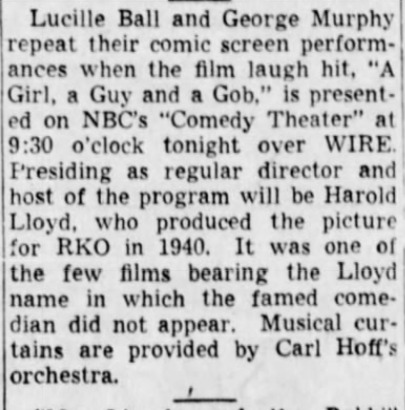
Synopsis ~ A shy, quiet executive for a shipping firm who finds himself with a dilemma: he's become smitten with his young temporary secretary but she's the girlfriend of his Navy buddy - and the buddy is scheduled to be discharged in only a few days.
Note: “Gob” is a slang word for a sailor. This term first showed up in regard to sailors around 1909 and may have come from the word gobble. Reportedly, some people thought that sailors gobbled their food. The term also may come from the word gob, which means to spit, something sailors also reportedly do often.
CAST
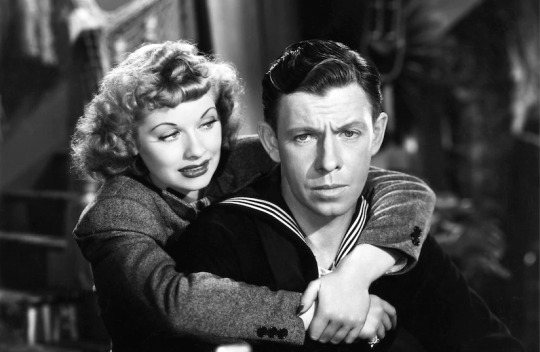
Lucille Ball as Dorothy (Dotty) Duncan aka ‘The Girl’
George Murphy as Claudius (Coffee) Cup aka ‘The Gob’ ~ was in four films with Lucille Ball between 1934 and 1941. In 1959, Murphy served as guest host of “The Westinghouse Desilu Playhouse” when Desi Arnaz took a role in his own anthology series. He was also a performer in “The Desilu Revue” aired in December 1959. As the host of “MGM Parade”, he interviewed Lucy and Desi in February 1956.
Will Wright as Pop Duncan ~ would appear with Lucille Ball in the 1949 film Miss Grant Takes Richmond, and played the locksmith in “The Handcuffs” (ILL S2;E4) in 1952, and the Bent Fork Sheriff in “Tennessee Bound” (ILL S4;E14) in 1955. The role was played on screen by George Cleveland.
EPISODE
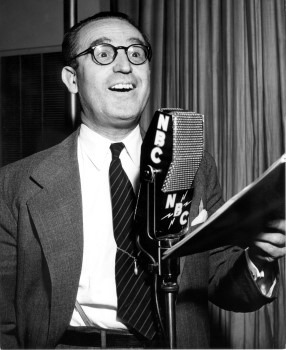
The announcer introduces the evening’s play and its stars as well as the director, Harold Lloyd. Lloyd states that he has recruited the original stars of the film version. Murphy and Ball take the microphone. Lucille’s next film, MGM’s Without Love, is briefly mentioned. Llloyd sets the story,
Executive Stephen Herrick is taking his date to a piano concert at Carnegie Hall when he discovers people are already sitting in his usual box seats. It is Dotty (Lucille Ball) and Coffee Cup (Murphy). Lucy whacks Mr. Herrick in the head with her handbag when he threatens to call the manager. Coffee Cup admits that he did not exactly purchase the tickets legally and they decide to make a hasty departure.
COFFEE CUP: “For my money, Count Basie’s got it all over this guy Josie Iturbe.”

José Iturbi Báguena (1895-1980) was a Spanish conductor, pianist and harpsichordist. He appeared in several Hollywood films of the 1940s, playing himself in the 1943 musical Thousands Cheer, which also featured Lucille Ball. Lucille Ball mentions Iturbi again on an October 7, 1949 episode of her radio show “My Favorite Husband.” William James "Count" Basie (1904-84) was an American jazz pianist, organist, bandleader, and composer.
Next day, at Mr. Herrick’s office, his new secretary arrives - it is Dotty! Herrick threatens to throw her out if she won’t leave and Dotty quickly explains that she gave him the money for the tickets but he lost it on a horse. Herrick reluctantly agrees to hire her anyway.
Sailors Coffee Cup and Eddie meet Dotty for lunch. He begs Dotty to allow him to get a tattoo like Eddie. She is adamant - no tattoos. Eddie claims he can grow four inches right in front of them - with his heels flat on the ground. Mr. Herrick comes by and sees the growing crowd watching this. A bet is wagered if Eddie can truly do it. Dotty borrows five bucks from Mr. Herrick so that Coffee Cup can make the bet.
When Eddie succeeds, the assembled crowd soon turns into a mob and there is a fist fight and a broken store window. Mr. Herrick gets knocked out by a big lug, who in turn is knocked out by Dotty’s lethal purse.
END of ACT ONE

A live Old Gold Cigarette commercial touts that the tobacco blend includes apple honey, to prevent dryness.
Earlier in her career, Lucille Ball was a spokes model for Chesterfield Cigarettes. Later, she would be associated with Philip Morris when they agreed to sponsor “I Love Lucy.” Despite this, Lucille Ball herself remained a Chesterfield smoker for most of her life.
“And remember, when the gremlins gang up on you, why be irritated? Light up an Old Gold.”
ACT TWO Eddie and Coffee Cup have taken Herrick back to Dot’s busy brownstone to calm his nerves, giving him a sleeping powder. There he is watched over by Mr. and Mrs. Duncan, Dot’s parents. Her father is listening to “The Lone Stranger” on the radio while Mrs. Liebowitz (an upstairs neighbor) is about to have a baby!

“The Lone Stranger” is a comical reference to “The Lone Ranger.” The masked cowboy first appeared on radio in 1933 and proved to be a hit. It spawned a series of books and later an equally popular television show that ran from 1949 to 1957.
Coffee Cup comes by to check on Mr. Herrick, who is only concerned with finding his pants. Dotty comes in to help him find them. They are about to set the table for dinner - corned beef and cabbage - when Liebowitz number 9 comes in to the world. Mr. Herrick wins the baby weight pool. He agrees to go out on the town and celebrate with them.
A few days later, Dotty is late back from lunch, showing off her new engagement ring. She tells Mr. Herrick that Coffee Cup has a wrestling match that night. If he wins, the prize money will pay for their wedding. Mr. Herrick confesses that he hopes Coffee Cup loses.
At the wedding chapel, Eddie wonders why he asked Mr. Herrick to be their best man when he is obviously in love with Dotty. Mr. Higgenbottom, photographer, interrupts to get a photo, mistaking Mr. Herrick for the groom. The sailors need to get back to the ship, so Coffee Cup allows them to give Dotty a farewell kiss before the wedding. Mr. Herrick gets in line. Dotty suddenly feels awkward and runs out.

Coffee Cup follows her to talk privately. She has been crying. He wonders if she has feelings for Mr. Herrick. While she fixes her face, Coffee Cup steps out and tells Mr. Herrick he should go in and console her. Coffee Cup tells Eddie to inform Dot’s mother that he went to get cigarettes.
END of ACT TWO

Another live commercial for Old Gold Cigarettes. The announcer reminds listeners that the men in uniform get first consideration in the distribution of Old Gold Cigarettes.
ACT THREE
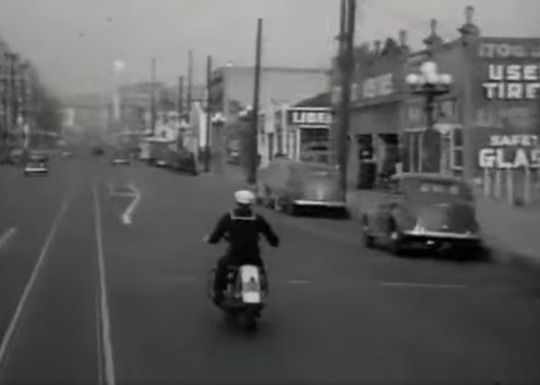
Harold Lloyd sets the scene. The bride and the best man are at the alter, but the groom is nowhere to be found. Mr. Herrick realizes what has happened and rushes out to follow Coffee Cup, who has driven away on motorcycle. Mr. Herrick yells at him from a taxi cab.
Suddenly, Coffee Cup crashes, but is unharmed. When Herrick threatens to bring him back to the alter, Coffee Club slugs him and tells the cabbie to take them back to the chapel. He writes a note on the unconscious Herrick’s shirt front and with a loud honk of the taxi horn, speeds away toward the ship yard. Dotty and the wedding party find Herrick on the street and she reads the note:
“Dot, this guy loves you and I know now you love him. It’s a good thing I found out before it was too late. See you next time I’m on leave. ~ Coffee Cup. PS: The wedding’s all paid for, why don’t you use it and you and him get married.”
At the shipyard, Eddie catches up with Coffee Cup, who reports that Dot did indeed marry Mr. Herrick. As they board the ship, they discuss plans for Coffee Cup’s new tattoo.
END OF EPISODE
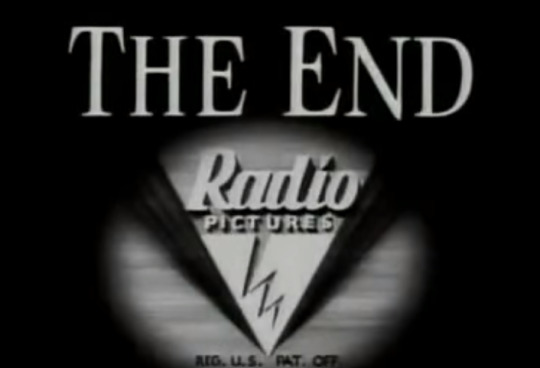
Harold Llloyd, George Murphy, and Lucille Ball bid audiences goodnight. He reminds them to tune in next week for Jack Haley, Jimmy Gleason, and Eve Arden in The Milky Way.
The Announcer thanks RKO, producers of Experiment Perilous.
George Murphy appeared courtesy of MGM, producers of National Velvet.
#Lucille Ball#George Murphy#A Girl A Guy And A Gob#Radio#Old Gold Cigarettes#Harold Lloyd#RKO#The Lone Ranger#Thousands Cheer#Will Wright#1945
8 notes
·
View notes
Text
Okay since I know it’d never get made here’s my concept of a remake for Back to the Future
Marty McFly is a girl, a biracial girl at that. Instead of being lazy, she’s late places and always tired because she’s hella overworked. It’s still set originally in 1985, and Marty is an A+ honors student, plays guitar and sings lead in a band and is dating her drummer (also a girl), and she has a job as Doc Brown’s Lab assistant.
There’s a dance planned that’s 50′s themed, and Marty is trying on her dress when Doc calls and asks her to come immediately to film an experiment, but she doesn’t have time to change. Experiment happens, he gets shot by the Libyans and Marty has to get away in the DeLorean.
Crash happens, Marty has to hide the car, and then tries to find Doc. Along the way, she accidentally saves her mother from getting hit by a car and meets her family, etc. Her mother is under the impression she’s a fellow white girl and they form an acquaintance. She meets her dad at a diner (still a nerd, still bullied only now with racist undertones and in stolen clothes he’s left with the impression she’s a fellow black dude)
She tracks down Doc and he’s having a party. She infiltrates it, he’s drunk and tries to hit on her and she hits him in the head with a bottle. This injury gives him the idea for a flux capacitor (this happened in the original screenplay only this time Marty is the girl he offends).
After everyone else leaves and she’s patching him up he sketches the idea and she explains the situation to him, and answers a bunch of questions to prove she’s from the future (Ronald Reagan? The actor?!?!?!) and that they know each other. Because she’s already met her parents and possibly interfered, she has to make sure they still end up together at the proper time.
She bounces back and forth between them, forming friendships and learning more about both and manipulating them together. She sets them up for a date at the dance (California schools were integrated in 1945 so this isn’t an unbelievable stretch), and she drives her mother so her grandparents don’t know she’s going on a date with a black dude.
Marty’s Dad still gets his nerves up and punches out the bully, but there’s no additional witnesses and Marty’s mom takes credit for it so he gets away. They go to the dance, Marty fills in for the injured guitar player (wearing his clothes so she blends in) and plays a song that hasn’t come out yet (Maybe “Can’t help falling in love” since that didn’t come out since 1961 but the band would know the tune since it’s basic for music students)
Big climatic ending with the lightning and Marty making it home safe, finding out her band got the gig for the dance and her parents surprise her with a car (not a super expensive giant truck, maybe just a good van she can haul her stuff in that will get her places faster)
Doc has to disappear, obviously, cuz of the Libyans, but he crashes back in at the end of the movie when she’s with her girlfriend and says that they have to go to the future to save their kids, which leads into the next movie. This one, instead of a real alteration is a causality loop where everything Marty does insures the future is exactly how its supposed to be, the timeline she lives in rather than a new one that raises a whole bunch of terrifying questions. Also, no Oedipal complex.
In the second movie, they travel to 2015, only in this version it’s a realistic 2015, no flying cars (but the DeLorean can still fly and runs on green energy because the Doc has traveled farther than this) and Marty has to manipulate things from the shadows to keep her son from getting shot by police.
Instead of a Sports Almanac, Marty grabs something like an economics book that shows the companies with the biggest growths and hardest falls so she has an investment edge and it winds up in Biff’s hands, cue the second half story of her having to fix the fucked up timeline.
Marty thinks Doc is dead, but then gets the letter and finds out he’s alive in the past and in the third movie goes back in time to 1885. Runs into her ancestor, a man born into slavery who is now a rancher with a lovely Native American wife and two cute af kids. Marty works with Doc Brown, saying she’s his daughter or w/e while they work to keep Doc from being murdered. Doc and Clara still fall in love, they still beef with old-timey Biff, they still succeed, Marty returns to her own time and Doc fucks off into the sunset with Clara and their kids.
Still plenty of room for repetitive and parallel jokes and plenty of organic comedy can arise from these scenarios.
Idk I’m just glad I got this out of my system.
1 note
·
View note